#low-key miss Android system and how fun it is
Explore tagged Tumblr posts
Text
no longer team iPhone and will be less active on social media.....
#i know I'm lying to myself because too be quite honest i love Tumblr too much but yea def about to be done with the former 🐦 app#OMG this phone is so cute#low-key miss Android system and how fun it is#no but the camcorder mode and dual pic and video......gag#anyways will be taking pics and updating in case ya know.... you care 🙃
2 notes
·
View notes
Text
Detect Magic: the Sixth World Tarot by Echo Chernik
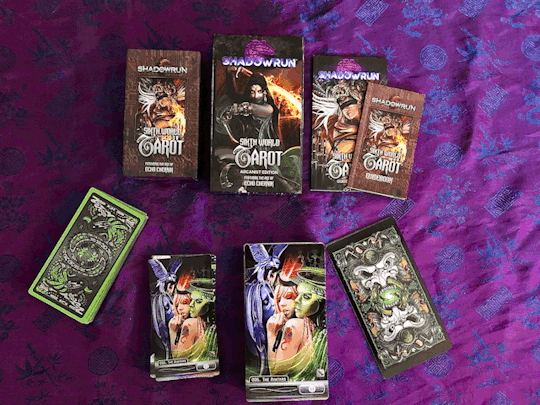
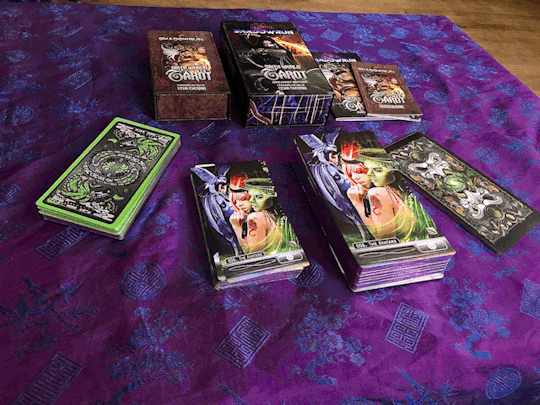
(pictured here- the deluxe edition [left] and the Arcanist edition of the Sixth World Tarot by Echo Chernik)
Y'know, it's been a long time since I did one of these, but here goes. It's time for another Detect Magic review. I haven't put the Dork Magician hat on for a while, so let's give this a whirl!
Today we're taking a look at the Sixth World Tarot, by Echo and Lazarus Chernik. She has this available on her website (click the above link), which come signed by the artist and the author. I'm a bit bummed, I bought a copy of this deck juuuuust before she started signing them. Not her fault, but still. XD
For those of you unfamiliar with Shadowrun, it's a cyberpunk dystopian magic-and-mech RPG setting and fantasy novel universe which originated in the late 80's. The premise is that magic is growing stronger, the world experienced a big Awakening in the early 2000's, right around the same time that corporations managed to gain extraterritoriality. So, you have dragons running huge megacorps, which basically enslave people to be lifelong wageslaves from birth (or as soon as they can get their hands on a desired talent), immersive VR Matrix hackers, cyberware enhanced fighters and magic practitioners acting as "deniable assets" to said corps for all sorts of shady business.
Hence the name "Shadowrun."
This setting, one of my absolute favorite settings out there, has had the misfortune of developing a sort of eerie prophetic element akin to the Simpsons and its bizarre track record of prediction of ludicrous world events. Shadowrun was intended to be a cautionary tale, not an oracular one. That being said, that does make a tarot based on Shadowrun more than a little on-the-nose for predictive purposes. After all, they're telling the future without even trying. Wait until they actually put some effort into it...

All right, time to Detect Magic!
Accessory- Crit (4 out of 4) Stunning artwork, evocative imagery... this deck is gorgeous. It's so beautiful, and so intricate and well made, that people who don't even read tarot (or even particularly like tarot) buy several copies for their geeky collections, and even people who don't particularly care about Shadowrun have dropped their jaw when I showed the deck to them.
A bit busier than I'm used to working with (not the art, but the extras which I'll explain later), I was pleasantly surprised at how much I loved the cards when I first got them. The box for both editions I own are a nice durable gloss with a magnetic foldover closure, there's a ribbon inside each to help pull the cards and book out of the box, and the decorative artwork is gorgeous and fitting with the setting. Definitely aesthetically pleasing enough to take places, and durable enough to resist scuffing or tearing for on-the-go divination and gaming use.
Tome- Crit (4 out of 4) So, the Tome section of this review is supposed to be about how well the cards help one in the pursuit of learning magic and practicing geekomancy. And... really, I don't think I've found a deck (or any artifact of fandom) quite as good as this.
Let me explain.
Tarot, in the sorcery practice I teach, are already basically a pictorial grimoire, describing life in a way that allows us to learn the hidden movements, mysteries, and forces at play in our world. Art is good for things like that in general. It helps you see the world through a special lens, one which allows you to see things you might have missed.
The thing is, the lens of this deck is the Shadowrun continuity, which as I said earlier, has proven to be more than a little prophetic, and alarmingly so.
The magic system of Shadowrun is pretty adjacent to our own. Life force lines, spiritual power sites, astral projection and spirits and magical "energy" forms, initiatory mysteries... it's all pretty much the same as our own reality, just juiced up a bit, with some extra game elements added (don't even ask me about insect spirits).
This makes the deck particularly helpful if one wishes to learn magic in any of the myriad ways described in Shadowrun (and they're particularly respectful and diverse and true-to-life in their tradition descriptions).
BUT, it also has an entire lore-book called the Book of the Lost associated with it, which explains all these little secret sigils and images and easter eggs stored throughout the deck, which can be used for gamebuilding and storytelling, but are designed to be arcane indicators and omens, among other things. And the kinds of symbols they use range from sentences or mottos in dead languages, all the way to waveform patterns and dot-matrix maps. I swear, if you're one of those people who like puzzles and cryptography, this deck is even more fun than the Hermetic Tarot.
In summary, while you'll have to get some Shadowrun sourcebooks to really get deep into the canon lore, there's so much of it that the cards really show you on their own that I don't consider this a setback at all. Feel free to deep-dive with this deck, you'll learn a TON about magic if you let it guide you.
Relic- Success (3 out of 4) If you read the Book of the Lost, or Unearthed Arcana, or any of the 5th edition Shadowrun magic sourcebooks, you'll see that "tarot magic" is an up and coming thing in their canon. Each text helps you see how practitioners use the cards in-game for spellcasting, ritual magic, initiation practices and spirit summoning. The Tarot are already really valuable as central objects of importance to certain kinds of magical practice. This particular deck is designed to be so handy a central object that there's an entire book dedicated to it.
Weapon- Success (3 out of 4) The only reason I'm rating this a success instead of a crit is because they don't provide enough spreads in the various associated books for one to immediately begin casting spells with them, which means you'll have to do some designing. They do have a couple solid unique spreads for basic divination though.
The deck's canon in-game suggests ritual practices like gathering and doing a ritual with sets of related cards, and one such ritual was easily adapted in my own practice, into the Lucky Kimono spread I designed (which people can read about on my Patreon at the higher tiers). So, even without outright including spell-spreads, they sort of gave us clues anyway.
Again, you're going to need the sourcebooks, but it's only a few of them, and they're well worth a read even if you're not planning on playing the game (and I don't play in the actual Shadowrun mechanical system, though I do like the sourcebooks for campaign setting ideas).
Overall Rating: Critical Success (14 out of 16)
Achievement Unlocked: Novahot Echo's artwork is already legendary in the dork realms of geekomancy. She's done work for Dungeons and Dragons, Mage: the Ascension, House of Night... she's even working on a Fate: the Winx Saga playing card deck right now. Her art-nouveau delicacy combined with the powerful non-pandering way she draws women means that her paintings pack a punch!
That being said, it's rare that we see professional artists create a tarot deck of this magnitude as a gaming accessory. Most tarot decks of this caliber are found in professional occult catalogues or as independent projects by artists just wanting to flex their skills for their own reasons. To have a deck like this, clearly a labor of love by all involved, as a major element of gameplay within a franchise is really very special. And something this diverse, deep, and absolutely saturated with layers of ciphers and riddles... it's a geekomancer's dream come true.
Level Up: 2 Levels I think the only way anyone's going to be able to top this deck is if they manage to design a tarot deck that's also a fully immersive VR video game AND an AR game and divination tool useable with one's iPhone or Android. Legit, Echo and Lazarus left everyone in the dust. I haven't been this excited about Shadowrun since Shadowrun Returns first came out, and I got a set of dogtags that had a USB drive with the game on it.
It's just... crazy cool.
Full disclosure, I've had the deluxe edition of these cards for a while now, so I've basically been low-key squeeing about this deck since I first heard about it in 2018, even before I got it. I've been utterly astonished that people weren't more excited about them, and I wasn't hearing about them everywhere.
Before this, I created my own Shadowrun tarot method using the Universal Transparent Tarot (cuz, y'know, plastic and see-through and weird little mosaic readings all in one place, seemed fitting to me), and when I got the Sixth World Tarot? I don't think I've opened the UTT since!
Anyway, this is my review of this deck! Go follow the link up at the top of this post, and buy yourself one! And hey, let me know if you figure out the cool little map trick. My jaw literally dropped when I was shown that!
14 notes
·
View notes
Text


Tfw you have no chill when it comes to some of your polycho ships. Fic under cut (I hope)
"Markus! I want you to dance with me!"
Markus had looked up in surprise from where he sat at his desk when the younger RK model had approached him with the proposition. There was still a lot to do, North was working on rescuing and freeing more of their people, Simon and Josh were working on public relations with humans, and Markus? Markus was trying to figure out how to bring it all together and get the country to grant them legal rights.
"Connor," Markus began gently, not wanting to disappoint the android that had become such a close confidant over the months. "I have an important debate coming up for which I have to prepare. I don't have time right now."
That seemed to be the wrong answer as Connor walked up towards him and sat himself down on the desk across from Markus, a hand covering the papers the other had just been reading through so he had his full attention.
"You always say that when I suggest an activity." the brunet chastised with a soft smile. He understood of course. Markus was important, the world had its eyes on him since the android's freedom demonstration. But that had also worried Connor, it felt like Markus thought he wasn't allowed to have fun anymore, to relax, or spend time on things other than the mission. Connor understood all of that, but he also knew that wasn't a healthy way to live. Or at least that's what Hank told him.
When Markus avoided his gaze and tugged at the papers to get back to work, Connor persisted. "When was the last time you visited Carl? Or painted? Or just took a walk?"
A crease appeared over Markus' brow and the other didn't need to see an LED to know that meant Markus was upset and knew that it had been too long ago. "Look," the rebel leader snapped. "I'll get to all of that later, this is-"
"Important. I know." Connor interrupted softly as he reached his free hand out, his index finger hooking under the other's chin and tilting Markus' head up gently so they could lock eyes. "But this is important too. Please, Markus?"
There was a moment of hesitation from the older RK model, but then, much to the brunet's relief, he caved. Markus brought a hand over Connor's, clutching it and brought it up to his lips to softly kiss his fingers. "Okay." He looked up at the brown eyed detective, a smile of fondness on his face. "You win. You're very persuasive." He winked at the other.
"So I've been told!" Connor laughed, pulling away. "Put on something nice, but make sure you can move. This'll be fun."
🎵🎵🎵
The ballroom was filled with people and a cheerful upbeat instrumental theme played as the two androids watched the already dancing crowd. They spun, they tapped, they laughed, it was all very loud and atmosphere was filled with the energy of happy people forgetting their cares for a moment to get lost in a haze of music and movement.
"Well?" Connor looked at the other excitedly, curious to his reaction. "It's called swing music! Isn't it wonderful?"
"It's... full of energy." Markus laughed nervously as he moved closer to Connor to let some people through, both androids had dressed up in white button ups, but Markus wore red pants and a tie and vest while Connor had dressed in blue pants with suspenders to match.
It wasn't that he was nervous in a crowd, he stood in front of them regularly. But mingling? He hadn't done that in forever. "You know, I thought this was going to be a more low-key kind of thing, Connor..."
Connor smirked, "Stage fright? How unlike you, Markus." he pulled Markus by the arm and onto the dance floor. He proceeded to take both Markus' hands in his and held them in position, bringing a hand around Markus back. "I'll lead first to show you the steps. Then you can take over. Just follow me."
Weight on the right foot, two steps to the left. Two steps to the right. Left foot behind, rock back, then forward, bring it back and repeat. The steps were easy enough, when Markus looked back up from staring at their feet Connor was grinning from ear to ear, thoroughly enjoying himself. That alone already made this whole trip worth it.
"Okay, now you lead."
The two androids switched positions and Markus took over, leading the other through the steps, and apparently that's just what Connor had been waiting for. The little minx began swinging more to the music, hips swaying, shoulder moving, and Markus was helpless to do anything but laugh and join him.
🎶🎶🎶
They had danced and danced until the event ended and most went home. The two androids took seat on a bench near the side, giving their systems some time to cool down from all the heat, their hands still clasped together tight. The piano in the room now playing a soft waltz. Something Markus was more familiar with, if his memory served, it was Tchaikovsky's sleeping beauty waltz.
Connor's hair was in slight disarray as their dance had gotten more and more complex as the two got comfortable in the rhythm and flow of the music. He was the first to speak again and break the silence. "That was fun, wasn't it?"
"It was." Markus laughed, his voice warm and light as he looked to Connor gratefully. It felt so good to just relax and forget about all the problems for a bit. "Thank you for taking me here, Connor."
The detective returned the smile warmly and gave Markus' hand a light squeeze. "I know you're really busy, but I just wanted to remind you, it's okay to have fun too, and do things you want that don't immediately contribute to the cause. You're alive too, you should enjoy it. Just saying."
"Is that so? Okay." Markus stood up and turned to Connor again, holding his hand out for the other to take and then drew him in, one hand on the small of the RK800's back making his partner yelp and flush a light blue. "You had your dance, now lets do mine."
The two fell quiet as Markus taught Connor the waltz, their bodies moving in perfect rhythm with one another. It brought back fond memories.
"I used to accompany Carl to fancy parties where people would waltz." Markus recalled, a distant look in his eyes as if he were trying to relive the memory. "He always called them pretentious shitfests, but he'd always somehow find someone for me to dance with. To humour him."
"Oh? Carl sounds great... I wish I could have met him back then." Connor remarked quietly, just making conversation. His eyes darted all over the place as if he didn't know where to look. Swing dancing was fun, but waltzing, waltzing was close.. and intimate. Especially when you're the only two androids in the entire ballroom.
Markus seemed to pick up on Connor's nerves and smirked. "I think he and lieutenant Anderson would have been great friends. But anyway, there was one thing he always made me do that would make him laugh."
The RK200 swung his partner to the side, the two locking eyes for a moment before Markus leaned over and dipped his partner down just as the music ended, one hand secure against the other's back while the other held one of Connor's legs up in the air.
Connor yelped in surprise and his hand went from on Markus' shoulder to hold the other by he base of his neck. His face flushing a dark blue now as he laughed in excitement. "Markus! Careful! We're going to fall!"
"Falling for you doesn't sound too bad." The RK200 replied without missing a beat, a teasing smirk on his lips as he leaned in closer.
"You're so corny..." Connor's exasperation was quickly silenced by Markus' lips.
🎵🎵🎵🎵

95 notes
·
View notes
Text
Friday night funkin download lucky dog

FRIDAY NIGHT FUNKIN DOWNLOAD LUCKY DOG FOR FREE
FRIDAY NIGHT FUNKIN DOWNLOAD LUCKY DOG HOW TO
FRIDAY NIGHT FUNKIN DOWNLOAD LUCKY DOG APK
FRIDAY NIGHT FUNKIN DOWNLOAD LUCKY DOG MOD
FRIDAY NIGHT FUNKIN DOWNLOAD LUCKY DOG FULL
The Name, Brand and the Assets are all property of Developer or their respectful owner. Download which is compatible for your Operating System. Pay for it or just click 'No thanks, just take me to the downloads'. This application is not affiliated in any way with Developer. Steps (THE SMART BOI VERSION): Go to Click 'Friday Night Funkin'. It’s simple yet addictive, especially as the songs get more challenging. Friday Night Funkin VS Oswald The Lucky Rabbit Week + Cutscenes (FNF Mod-Hard) (Mickey Mouse Bro) Report. You play by matching various rhythms with your arrow keys to impress your crush, and more importantly, her dad. Friday Night Funkin VS Oswald The Lucky Rabbit Week + Cutscenes (FNF Mod-Hard) (Mickey Mouse Bro) NuNuHot. This is an unofficial application for Friday Night Funkin. Friday Night Funkin’ by ninjamuffin99 is a music-themed indie game with a straightforward but demanding task. go to mobile menu and launch the installed Lucky Dog 7 Friday Night Funkin.
FRIDAY NIGHT FUNKIN DOWNLOAD LUCKY DOG APK
With a friendly user interface and easy to use. Lucky Dog 7 Funkin Android Apk freeload Latest Version For Android.
FRIDAY NIGHT FUNKIN DOWNLOAD LUCKY DOG HOW TO
IOS How to download stickfigures & sounds: Download a NODES (or STK) or ZIP file, tap 'Open in Stick Nodes' before downloading. When done, tap it and 'Open With' > 'Stick Nodes'. This application is made for the FNF lovers, for the lovers of funkin night, for the FNF game. FRIDAY NIGHT FUNKIN' 'PRETTY DOPE ASS GAME' PLAYSTATION MAGAZINE MAY 2003 ISSUE. youth lacrosse camps 2022 gavin and stacey one-liners bar restaurant reservations walking lesson plans for physical education. When done, tap it and 'Open With' > 'Stick Nodes'. In this mode, you can practice your talents with the first three Friday night Funkin soundtracks and Friday night Funkin piano. To train, you can play Funkin Week 4's free play mode on Friday night.
FRIDAY NIGHT FUNKIN DOWNLOAD LUCKY DOG FULL
Hard mode is completely difficult and requires full adjustment. emma broyles miss america how to put up a 3x3 gazebo state of decay 2 manage account link not working fin feather fur black friday ad 2021 haniya nafisa education cubicle curtain revit. You can play on 3 difficulty levels each week. Friday night funkin ust download how to buy land from the county. Use the arrows to press at the right time to get the right tone, keep the song rhythm, and make the funkin sound as low as possible on Friday night.įriday Night Funkin features a story mode where you have to win the contest on many different tracks in a matter of weeks. On Friday night's Funkin soundtrack, you'll be asked to beat him in a rhythm contest and prove yourself a better vocalist. Friday Night Funkin The coolest rhythm game. To win the heart of your sweet man and win the support of his father. This is an open-source game, and you can support the developers here.Friday Night Funkin Music Game is a music and beat rhythm video game where you need to take part in a fight with your girlfriend's dad who is a seasoned Friday Night Funkin musician.
Tree-G: Artist, cutscenes artist, idea and story maker.
Good luck to you all, and we hope to see more of you since fun is always around the corner on our website! Developers: If you miss doing that once, it's not a problem, but if you do it too many times in a row, you lose and have to start all over again. To play notes, watch for when arrow symbols above BF match with one another above his head, and when they do, press the same arrow key too. You are going to choose between the story mode and free play mode for starters, after which, in either of them, give your best to play the notes of the songs so well that you reach their end and the progress bar turns in your favor since that is how you become the winner. The mods simple plot revolves around a mishap in which Daddy Dearest sends BF and, inadvertently, GF to the realm of Paw-Tucket.
FRIDAY NIGHT FUNKIN DOWNLOAD LUCKY DOG MOD
The mod contains 3 weeks with original music, and characters from the 2018 TV Series Littlest Pet Shop: A World of Our Own.
FRIDAY NIGHT FUNKIN DOWNLOAD LUCKY DOG FOR FREE
Bean is without a doubt one of the most popular and funniest characters to have ever appeared on television, both in his live-action show and the animated one, so it was only a matter of time before he was to be featured in our category of FNF Games online, where we are very happy that right now you can play for free the FNF Bean Battle mod!ĭefeat this famous TV personality on three custom songs that represent him:Īre you better at music than Mr. Friday Night Funkin - A World of Our Own is a crossover mod by NerdiestAlpaca.

0 notes
Text
AGM M7: The Unsmashable Anti-Smartphone
AGM M7
7.50 / 10
Read Reviews
Read More Reviews
Read More Reviews
Read More Reviews
Read More Reviews
Read More Reviews
Read More Reviews
Read More Reviews
Read More Reviews
Read More Reviews
Read More Reviews
Read More Reviews
Read More Reviews
Read More Reviews
Read More Reviews
Read More Reviews
Read More Reviews
Read More Reviews
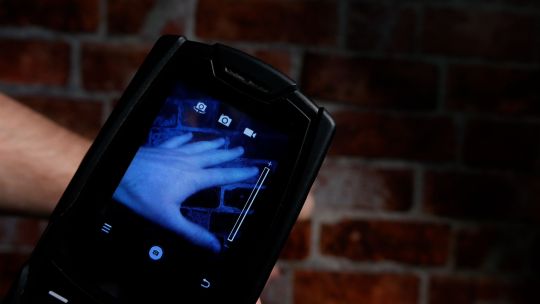
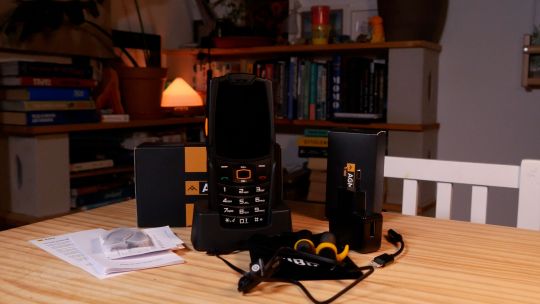
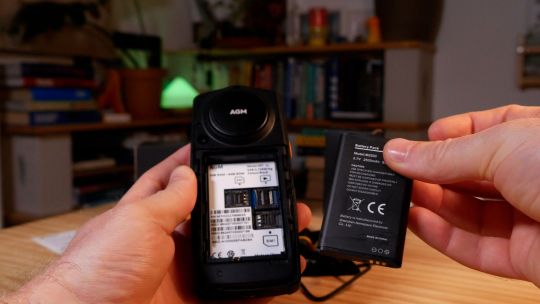





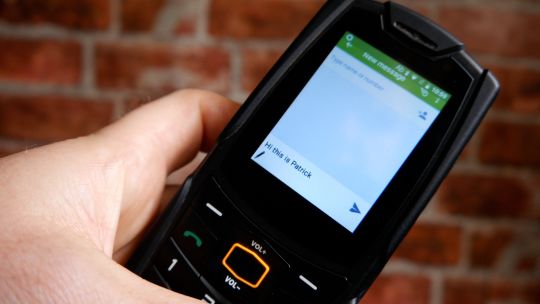


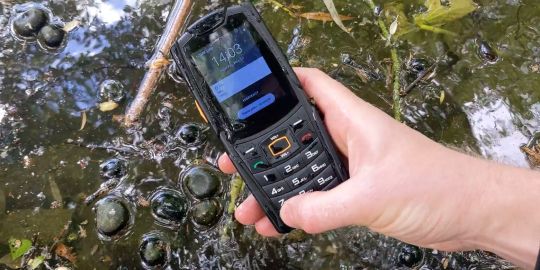


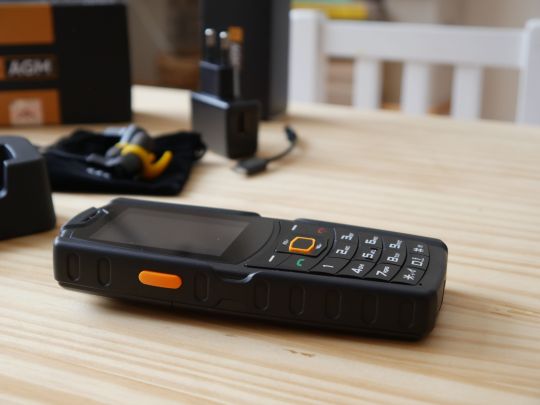

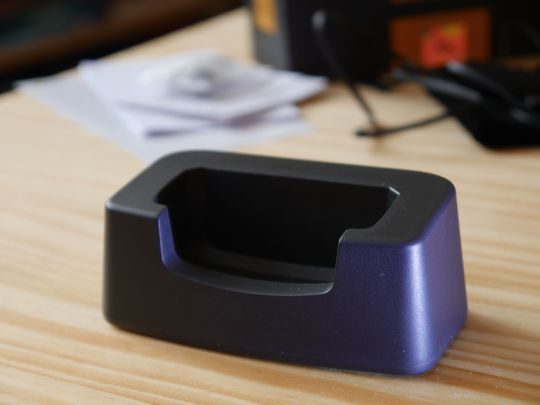
Shop Now
The AGM M7 is a budget semi-smartphone that is almost unbreakable and looks like something from the pre-smartphone era but offers much more. Those looking for a smartphone experience will be disappointed, but those looking for something unique will find this hybrid beast compelling.
Specifications
Brand: AGM
Storage: 8GB
CPU: MediaTek MT6739
Memory: 1GB
Operating System: Android 8.1 (Custom)
Battery: 2500mAh (TYP), removable
Ports: USB2.0 Type-C
Camera (Rear, Front): 2M/0.3M
Display (Size, Resolution): 2.4inch QVGA Touch Panel
Pros
Almost unbreakable
Battery lasts 4 days and is replaceable
Incredibly loud speaker
Dual-SIM and expandible with SD card
Cons
No Play Store or Google Account integration
Typing is clunky
Facebook, Tiktok and Browser apps poorly implemented
Buy This Product

AGM M7 other
Shop
// Bottom var galleryThumbs1 = new Swiper('.gallery-thumbs-1', { spaceBetween: 10, slidesPerView: 10, freeMode: true, watchSlidesVisibility: true, watchSlidesProgress: true, centerInsufficientSlides: true, allowTouchMove: false, preventClicks: false, breakpoints: { 1024: { slidesPerView: 6, } }, }); // Top var galleryTop1 = new Swiper('.gallery-top-1', { spaceBetween: 10, allowTouchMove: false, loop: true, preventClicks: false, breakpoints: { 1024: { allowTouchMove: true, } }, navigation: { nextEl: '.swiper-button-next', prevEl: '.swiper-button-prev', }, thumbs: { swiper: galleryThumbs1 } });
Smartphones complement modern living. Their bright touch input displays bring endless media sources from hundreds of apps right into our pockets. If smartphones are less robust and have shorter battery lives than the mobile phones that preceded them, the trade-offs seem worth it.
youtube
The AGM M7 begs to differ. At first glance, it seems like the anti-smartphone. A rugged brick that harks back to the pre-smartphone era with big touch buttons, a replaceable battery that lasts 4 days, and an IP 69k rating all for just shy of $100.
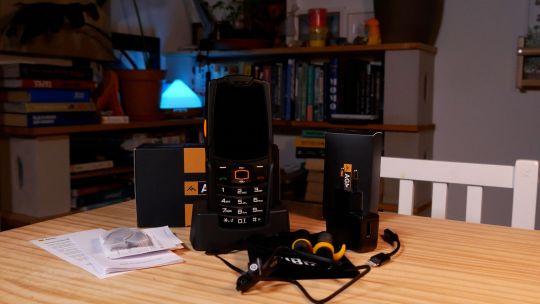
However, this phone isn't a complete throwback, as it features a modified version of Android 8.1, and its color display is also a small touchscreen. Oh, and it also has a massive 3.5-watt speaker on the back.

The AGM M7 is a strange but wonderful, loud and unbreakable, semi-smart phone, but is it right for you?
AGM M7: First Impressions
The defining feature of AGM phones is their rugged, almost unbreakable design, and the M7 is no different. For its form factor, it is large. At 14 cm tall it's a hair shorter than a Google Pixel 4a, but it's almost 2cm thick. It's chunky.

This size accommodates big, tactile buttons and a textured, easy-to-grip exterior. You also get a user-definable button on the left side along with a top-mounted LED torch - which makes it a much more practical prospect than regular smartphone flashlights.
Glass screens can still be a point of failure for rugged phones, so a smaller area of glass overall is probably an advantage for the M7. It does have cameras, but we'll come back to those later, as the defining feature is the 3.5-watt rear speaker. I've never seen anything like this on a phone before, but the prospect of a super loud ringer that can be heard even over machinery or foul weather will be a draw to many.
The battery compartment is well designed. After removing the cover, you are presented with another composite plastic seal protecting the battery, which is removable.

Removable batteries in a rugged phone are something to get excited about, but it does also come with a problem that we'll cover later in the review.
It's Android, but Not as You Know It
The paired down version of Andoird 8.1 that comes with the M7 supports Bluetooth, Wi-Fi, and use as a hotspot for other devices. It also features versions of WhatsApp, Facebook, TikTok, Skype, and Zello, along with some stock apps for calendar, clock, sound recording, and an FM radio. There is no play store, so what comes on the phone is what you get, and some things work a little better than others.

Unusually for an Android device, you can't sign in to your Google account, making it hard to bring contacts with you and sync the calendar without using a USB connection or storing data on your SIM card.
This is likely a product of the simplified Android build, but outside of that things like connectivity and setup feel identical to standard android.
How Rugged Is Now?
The AGM is IP69k rated, which means it is completely sealed from dust ingress, waterproof up to 2 meters underwater, and capable of taking drops of up to 2m. It's also functional from -20C to 60C.

In drop tests the M7 was solid. It took a few scrapes and a small dent to the speaker grate, but the phone never flinched or restarted when dropped. The battery cover would fly off sometimes, but the second cover kept the battery safe and in place.

The phone also survived being "forgotten" in a lake, used as a mud shovel, and being thrown around by a rampaging toddler for the best part of a day.
The phone also claims the MIL-STD-810H standard, which sounds fancy but doesn't actually have anything to do with the military directly, and is so unregulated that it's a meaningless metric of toughness.
However, it's not really an issue, as AGM takes ruggedness seriously. It's the hallmark of their phones and once again it seems like they've nailed it. This phone would survive things that I would not.
What's Good About the AGM M7?
On the surface, the AGM M7 is a simple phone designed to have a good battery life, take an absolute beating, and make a lot of noise. It does all of these things perfectly, and a phone that feels like a pre-smartphone era handset with WhatsApp, Skype and the Zello push-to-talk app (with the side button as transmit by default) is a good fit.
The top-mounted LED is bright and its position makes it an actually useful torch compared to other phones. Even when locked, a long press of the zero key toggles the torch, and the keypad is useable even with thick gloves.

The speaker is very loud, doesn't distort even at high volumes, and gives as close to a rounded sound as is possible for something this size.

The charging dock is a useful addition, though it is an optional extra available for a further $9.90 from AGM, and my M7 came with a fairly decent set of budget waterproof Bluetooth headphones made by JBL and AGM in tandem. I'm not sure if these come with every purchase, but it was a nice touch.
What's Bad About the AGM M7?

The Camera. In general. Low-quality cameras paired with low-fidelity color screens were little more than a gimmick when they emerged over a decade ago, and this is no different. It could be functional as a way of taking quick notes in good lighting, but nothing more.
The removable battery is a great idea and I applaud AGM for making it work in an IP69k rated phone. The only problem is that there doesn't appear to be any way to get spare batteries from AGM. They aren't listed on their website, and their EU aftersales website gives a 404 error. I'm sure that AGM will be able to provide them but at the time of recording this review, I haven't received a reply to the email I sent to the service team - though it has only been a few days.
No Play Store or Google account integration might seem a bad thing to you, but in fairness, the M7 does advertise this fact on the purchase page. The M7's failings don't come from what it lacks. Instead, they are the product of poorly integrating what is there. I'm not fully convinced that the smarter elements of this phone went through much development at all.
You Can Browse, But You Won't Enjoy It
When mobile phones initially began adding basic browsers to their firmware, they were a nice idea in principle, but functionally near unusable. Fifteen years on, the M7 falls into this trap for different reasons.

The browser works for basic searches, and you can even log in to your email services, watch YouTube, and enable desktop mode for logging into various services. The issue here is the screen. It's just too small and low resolution to really work. Pair with that the fact that the browser requires frequent use of the touch screen to access some buttons and selections, and it quickly becomes something you'd only use in a real pinch.
The same is true of the TikTok and Facebook apps: fine ideas in principle but not much fun to use with the small screen and keypad combination.
Demon Texters of the 90s Will Be Disappointed
Typing, in general, is painful on this phone. Now I'm sure some of you are thinking "of course it is, it's a keypad." That's fair.
But, to people of a certain age, keypad typing was the norm. When I was a teenager a seemingly revolutionary technology called T9 predictive texting made writing messages much faster. Instead of picking each letter individually, you could tap each letter key once, and the phone would predict words from the possible letter combinations and put them in place, allowing you to change it after the fact when it got it wrong.

The M7 does have word suggestions, but they pop up after the fact and it doesn't have any single keypad pressing input. I'm aware that this may not be an issue to some folks - T9 was popular for a relatively small slice of time, some older folks never adopted it, and some younger folks won't have even heard of it.
I can only assume this was the case in the AGM team, as when comparing the typing user experience with phones released 20 years ago, it is a massive step backward and a missed opportunity. T9 emulation for Android already exists, I don't know why it's missing here.
If there is one general flaw to this phone, it is the implementation of Android it uses. It is clearly still biased towards the touch screen and the keypad suffers as a result. This is no problem when using the M7 like an old-school mobile phone, it just makes the smart elements feel a little clunky overall. The thing is, once you've settled your expectations, even these seemingly glaring flaws don't matter much.
Criticizing elements of the M7 doesn't change the overall experience - one I did not expect to enjoy but thoroughly did, and still do.
AGM M7: The Verdict
It became clear while making this review that a phone with one foot in the mobile phone era and one in the smartphone era is never going to be able to stand up to either one individually, especially sitting at the $100 price point.
After a couple of days, the flaws were mostly forgotten, and this hybrid monster of a phone began to make sense. It's not going to replace a smartphone, and I'm not even convinced it would make a good phone for non-tech savvy folks or the elderly, but I'm still using it, and I think it comes down to what the M7 offers.

For some folks, limitations are liberating. We've grown accustomed to always having the digital world in our grasp, and it can be especially difficult to drag yourself from it when you are a freelancer with no concept of a healthy workday!
For the 9 days I reviewed this phone, I carried my smartphone turned off as well just in case I needed it. It turns out I didn't, and after day 3 I didn't even miss it. The AGM M7 takes away everything, then adds back a few things you need. Yes the Tiktok and Facebook integrations are clunky and yes the browser and text input is a mess, but it's functional enough to use in a pinch.
I've loaded albums onto into the memory that I meant to get round to listening to years ago, actually selectively downloaded podcasts rather than just listen to whatever is just there. I have relatively quickly let go of the feeling that I need to document every interesting aspect of life with photos I'll likely never even look at again.
It's nice to not worry about battery life, it's nice to know I can just throw it in my pack and head out riding, running, or even wild swimming, and know that not only will the phone be ok, but that checking emails, Slack or wasting time on Reddit aren't even viable options despite having a fully connected Android phone with me.
It's not a retro throwback, but it's not quite a smartphone either. The AGM M7 is unique, and for some people, it represents the balance they desire. I've no idea if AGM had this in mind when they threw this insane combination of features into a phone - but it works for me.
AGM M7: The Unsmashable Anti-Smartphone published first on http://droneseco.tumblr.com/
0 notes
Text
Band Yarouze Review: It’s a battle of the bands!... and I love a fish man

Band Yarouze (バンドやろうぜ!) is a Japanese card collecting rhythm game made by Aniplex and Sony Music. The goal of the game is to collect cards through gachas and events by playing various songs performed by the four main bands: BLAST, OSIRIS, Fairy4pril, and Cure2tron. Unlike the other games, the player’s character isn’t really in the story; you are more like a bystander or “god-like” being who just observes and sometimes speaks to the members. Therefore, all you do is play the songs and unlock cards, events, characters, and band stories.
I started playing Band Yarouze around March 2016 because the same friend who recommended Ensemble Stars wanted me to suffer more… I’m not even kidding. Even though I like rhythm games, I wasn’t too interested in playing this one at the time. A few characters caught my eye, but not enough to invest into the game. However right now, it is my second favourite game and brings me just as much suffering as Ensemble Stars does.

Main gameplay: 5/5 ♥♥♥♥♥
The gameplay for Band Yarouze is extremely simple: tap, hold, hold-slide, and swipe (left and right) notes when they slide down towards the bottom of the screen. The notes follow the beat of the song, so it’s easy once you understand the flow. Rhythm games are very popular in Japan, but each of the mechanics are slightly different. I think out of the ones I have tried, Band Yarouze is the most forgiving. For example, some other rhythm games need hold and release notes at a specific time or they won’t count. This makes it difficult to play songs with a full combo, especially if you’re on expert mode with a max note speed. However, in Band Yarouze, if you press a hold note a little longer than indicated, it won’t penalize you unless you miss the next note.
Another interesting point of the game is the event function. Almost all Japanese games have some type of event aspect. In typical games like Ensemble Stars, during the event time you play through and complete lives to gain points and rank up to collect event cards. But in Band Yarouze, you complete the song to gain points and objects (like keys, buns or chips) to either collect points, rank, or exchange items for event cards.

For example, during an event called, “Stand by Me GIGS: Nice Dream, Journey Mood,” (photo above) you try to collect points and rank up to get special cards and items such as stones and gacha tickets. You can also win steamed buns after clearing the event song and use them to play the time-limited event songs. However, in the current event, “Advent of the Quattro Virtuoso GIGS: Dante of the Purgatory,” (photo below) you go through the story challenges and play special lives. If you clear the Live, you win chips and exchange them for limited Super Rare (SR) and Rare (R) level cards. I find collecting points and ranking events easier and more fun than just exchanging items, even though it is easier and less stressful. I like that Band Yarouze changes the rules and mechanics for events because it keeps the game interesting. Even if you play the same song repeatedly, it is still challenging to collect or complete the event. I kind of wish other games would also change their event rules from time to time.

(Left: unbroken card, Right: Broken card. P.S. This is a boy, all of Cure2tron are crossdressing boys)
Unfortunately, Band Yarouze is only available via the Japanese app store and Google play store. As I mentioned in the Ensemble Stars post, you can download a separate Android Game Platform or create a Japanese iTunes account to access these games. There aren’t too many tutorials for Band Yarouze but gyrotalon from Reddit made a basic English guide to the game. This helped me understand the navigational system and how to BREAK and level up cards. You can also check out Banyaro English Tumblr and Banyaro English Twitter for translated event announcements, basic character information, and replies to questions from other Band Yarouze players.
As always, it is free to play and has in-game currency called “medals.” I didn’t use to care about the gacha in this game before since it is kind of expensive (it costs 500 medals for a ten card pull). However, one of my favourite characters got a pretty card and it all went downhill from there. So far, I’ve spent a bit more than $350 on Band Yarouze, which I’m not even surprised. Honestly, since the past few events have been featuring my favourite band or characters, I’m surprised the number isn’t much higher. I spent a lot a few weeks ago, trying to get a SR of Shin. He came home after four or five 10-character rolls… but at least he came home… unlike a certain someone [Cough Koga Cough].
Overall, Band Yarouze is really fun and addictive. Even if you aren’t good at playing music games, you can still have fun trying to beat your score. You also probably don’t need to buy medals unless you want a certain card, but the game gives you many rewards along the way. I’d recommend this game to any beginners who don’t have much experience playing rhythm games. The songs are well composed, the characters are quite unique, and the game is easy to play.

Characters: 4/5 ♥♥♥♥♡
When I started playing Band Yarouze, there weren’t any characters that immediately caught my eye. My friend pointed out some characters that were my type and sadly, I completely agreed and my obsession began. Each band includes one vocalist, guitarist, bassist, and drummer. They each also all play a different type of rock music adapted with modern Japanese elements: BLAST is classic/aggressive rock, OSIRIS is emotional/punk rock, Fairly4pril is alternative/indie rock, and Cure2tron is electronic/pop rock. I have members I like within each band but OSIRIS is by far my absolute favourite.
Their music and appearances are cool and edgy but their lyrics and sound are still so expressive. I love all their songs! My top three are “Darkness,” “Voice,” and “Heavenly Breeze.” Although there is only one vocalist, I love each member’s voice for its unique sound and way of speaking.

(My favourite Kyo cards. He is a beautiful angel with a beautiful voice who should never feel alone.)
Takara Kyo (Kobayashi Masanori) has a quiet but strong voice. His shy personality easily shows through his looks and attitude. But when he performs, it is breathtaking. Especially in “Heavenly Breeze,” Kobayashi’s vocal range and consistent control create a passionate and memorable performance. I’m sure I have cried listening to him sing; it was just so beautiful. Kyo struggles with his thoughts and problems internally but can relieve his stress through his singing. I can’t wait to hear more songs from him that are absolutely ethereal.

(My favourite Ray cards. He is a silly and stubborn dork who should always dream big.)
Ray Cephart (Hanae Natsuki) has a confident and silvery voice. His voice reflects his energetic and playful side, as well as his serious and bossy side. Ray’s overall tone is quite high but leaves a ringing that isn’t necessarily bad. Although, within OSIRIS, I like his voice the least I still find him very charming and sweet. He may act like an idiot sometimes but it’s because he is a big dreamer who wants OSIRIS to become the best band in the world.

(My favourite Makoto cards. He is a strict realist who should continue to follow what he believes is right.)
Kurusu Makoto (Uchida Yuuma) uses a lower and quiet stern voice compared to Kyo and Ray. As an active medical student, his personality is always serious and blunt which easily reflects in his voice. He has this mix of sexual attractiveness and mysteriousness in the way his sentences flow. It’s hard to describe but I’d want to hear his voice if was a tutor explaining math I don’t understand. Even though he can be cold and harsh, he still dedicates himself to practice bass and help the other members of OSIRIS realistically achieve their goals.

(My favourite Shin cards. He is a mature, fish-loving old man who should always smile and help others.)
Finally, Koganei Shin (Umehara Yuuchirou) has a low and husky voice. I’m simply in love with everything about him. His voice is so calming and reassuring, it makes me smile easily. I really wish he had a singing part since he voices Hasumi Keito from Ensemble Stars and other popular idol characters from different games. He has a beautiful singing voice! Let my drummer boy sing! [Internally weeping].
As the leader of OSIRIS, Shin’s reliable personality easily reflects in his voice but so does his silliness and extreme love for fish, especially Hachibiki Sashimi (he works at his parent’s fish shop). Though I hope he always helps cheer people up, either with his music or simply his personality. I must say out of all my favourite characters from the mobile games I’ve reviewed so far, realistically, Shin is the closest to my idea type. He is handsome, cool, friendly, reliable, strong, smart, and responsible; what’s not to like? I know he’s only a 2D character and will never really exist, but if he did, I think I would just cry forever.

Story: 3/5 ♥♥♥♡♡
The main story in Band Yarouze is about the characters’ struggles and difficulties about debuting as a band. There are sometimes choices during a character’s story, but whatever you choose does not really change the outcome. There is no additional gain if you answer “correctly” except to see the characters’ different reactions. Event stories are usually really weird. Sometimes they have impossible storylines like the band members turn into eggs on Easter, or they get transported to the Underworld on Halloween. It could never happen, even in the game’s universe, but it kind of happens anyway and fans still love it. Sadly, there are very few English translations of the story. Even Banyaro English Tumblr doesn’t have full translations of every chapter, only the prologues and some event chapters. I think the game is either not popular enough to have full translations or the game doesn’t have a large international fandom: both are likely. I’ll wait for the day someone translates them all so I can enjoy my silly boys being silly.

Overall: 4/5 ♥♥♥♥♡
Band Yarouze is an amazingly fun, simple and addicting game for anyone to begin playing. The songs are catchy, the artwork is beautiful, the characters are unique, and the story is wild. I don’t completely regret spending money on this game. But I think would be little kinder to my wallet if OSIRIS and Shin were not involved. I would recommend this game to beginners who like great quality music and art. This would be your best option to learn how rhythm games work differently than puzzle, RPG, or other card collecting games. It can teach you to appreciate music and help you diversify in the types of games and music you may play or listen to. I think it will also make you feel like a music genius even if you’re musically challenged like me!
#band yarouze#banyaro#osiris#shin koganei#kyo takara#ray cephart#makoto kurusu#rhythm#mobage#momobage#review
6 notes
·
View notes
Text
The Microsoft Surface Duo is Really Bad
The Microsoft Surface Duo has been in my hands for 72 hours and I can’t bring myself to use it much longer. After just three days, this will join the Motorola Razr on the list of the most deeply unpleasant devices I’ve ever touched, though there is a touch of hope here that the Razr didn’t have.
The hardware, while pretty and premium-feeling, is so weirdly presented from a modern mobile device perspective, but the software might be the biggest problem area of all. There is a lot of bad going on here, some of which could be addressed (software), while a big portion (hardware) is stuck with questionable decisions made by its creators.
This isn’t a review, because this device needs a lot of work, so instead here’s what Microsoft should address before anyone considers buying a Surface Duo 2. That’s right, I’m already looking to the next generation device because this version should be skipped unless Microsoft turns into a magician with Android software.
Hardware trying to hide its many flaws
Since the software is the critical piece here because it can be fixed, let me first run through my thoughts on the hardware.
I think Microsoft will get a bunch of credit for building a premium device, but let’s be honest – this thing is by no means close to being perfect. Building a fancy hinge and surrounding it with thin glass and metal should not distract you from a handful of obvious flaws. The missing pieces should not be played down and Microsoft doesn’t deserve a pass for leaving out NFC or a real camera or stereo speakers or some form of a display on the front.
Designed like a laptop, which aren’t meant for hands
Holding the Surface Duo can be an elegant experience, when it’s unfolded and both hands bend its beautiful hinge system to the perfect angle, letting you dive into content on each screen as you settle into the couch. But when you need to get something done, which often means folding the phone back to get on a single screen, the design immediately lets you know that it wasn’t made for this.
Pick up your current phone and feel where the glass meets the metal side panels. It’s smooth, right? You can’t actually feel sharpness or the edge of the glass in most cases. On the Surface Duo, it’s all sharp glass edges no matter where you grip from the side. It looks like Microsoft glued each panel onto a metal frame in a way that I could probably slip a fingernail behind it and peel it off (I’m not going to try).
Outside of the glass, the hinge, when folded, is sharp as well. So again, if you are in one-handed mode, depending on the hand you have the device in could mean a squared-off point stabbing you in the palm. It’s pretty unpleasant. Now, you may think, “Kellen, you are supposed to use it open with both screens,” but you aren’t really. The idea here is a device that meets your needs and can convert into a shape or style at any moment depending on the task. Typing is easier when the device is folded back, and that’s something you do on phones a lot.
What Microsoft designed with Surface Duo is a mini laptop. Like, if you took a picture of this with nothing to reference the size, you’d think it was a Surface laptop of some kind. The problem with that is laptops aren’t meant to be held. They are meant for laps or desks or tabletops, so you get this odd shape that isn’t hand-friendly for use cases where you might need a phone or a device more manageable with a single hand. And good luck ever opening it with one hand.
By designing a laptop, they also left out an external display, yet with an operating system like Android, you can’t really live without one. Notifications and always-on information are critical to staying productive with modern smartphones, but with Surface Duo, you almost have to buy a smartwatch to help keep you informed of your phone’s status since it can’t do it. I don’t know how Microsoft could have implemented a display that wouldn’t destroy their ultra-minimal aesthetic, but they certainly should have tried to figure out a way. I don’t get paid enough to do it for them.
Microsoft clearly worked so hard to make this device perfectly uniform, with matching interior and exterior glass placements, identical pieces on each side of the hinge, and no camera humps or exterior features, but that might have been a poor decision. This device is supposed to be functional in multiple ways, yet it struggles to do that because of its forced limitations.
It’s the worst camera I’ve ever used
As far as the camera goes, I never expected the Surface Duo camera to be any good, but I’m a bit shocked at how bad it actually is. This is low-level, 2012-esque bad. It actually reminds me a lot of the Essential Phone when it first launched, where you had this camera that could barely load, certainly couldn’t snap many pictures in a row, and processed like the summer intern was put in charge of imaging.
I took the Surface Duo with me for a short drive this weekend through smoke-filled Portland and attempted to take pictures from the car. I think I got two, both of which were so blurry I can barely make them out, while the rest were pictures of my lap, thanks to camera lag. The app is slow, the shutter button is never ready when you need it, and the image quality is unbelievably bad, as is the camera app.
The thing is, with the Essential Phone, we watched as they did their best to improve the camera in a hurry and someone ported the Google Camera app over for help. I’m not sure a Google Camera port would even help here.
I hate to hammer on the $1,400 price point over and over again, but Microsoft clearly sacrificed in one of the most important hardware areas of this phone so they can have a clean exterior with no humps and an interior that shuts completely flat. Sure, it looks minimal and pretty, but owning this phone means never being able to take a picture you are proud of in any lighting condition.
NFC…
The NFC thing I just don’t get. It’s a simple, tiny chip that makes paying for items hands-free. It has been a staple spec in almost all smartphones for a number of years now at all price points. Now, I know that Microsoft was developing Surface Duo before COVID destroyed the world and scared us out of touching anything with our hands, but leaving out NFC is something we all hammered OnePlus for back in 2015. It’s 2020, and while I get that not everyone has fully adopted mobile payments, they more than likely will over the next couple of years. If you buy this $1,400 device (!), you’ll never be able to make them.
Anything good about the hardware?
Of course! The AMOLED displays both look great, battery life is way better than I expected (easily full day), the fingerprint reader is quick and handy, and that hinge really is spectacular. I love the weight of Surface Duo and being able to adjust the setup to various angles to let me consume content or stay more productive. Microsoft has certainly done some praise-worthy things here, they just seem to have gotten caught up their own quest for extreme minimalism.
Software they should be embarrassed by
Oh boy, this isn’t going to be fun.
Before we dive in, know that my unlocked Surface Duo is on software version 2020.812.86. This is the update that I picked up straight out of the box and is currently showing from Microsoft as being the newest and most stable. While I haven’t looked at many reviews of this device, it sounds like this update was pushed to reviewers at the last minute and turned the device from unusable to the state I’m in now, which is still bad. I can’t imagine it being worse than this. Good lord.
Jank, lag, jank, lag, jank
When you first fire up Surface Duo, you want to dance between screens, run two apps at once, drop some in the middle to see what happens as they expand across both, and throw as many tasks at it as possible because no other device is setup the way this one is. Unfortunately, in this current early software, nothing works smoothly or enjoyably.
The animations are rough, jittery, and inconsistent in how they take you in and out of apps. I’d blame the 6GB RAM or the Snapdragon 855, but it seems more like Microsoft hasn’t tuned or optimized the OS properly or paid attention to little details.
I can’t tell you how often I wake the phone and it forces me to wait several seconds for it to be ready for use. Or when I swipe between home screens and I see this noticeably slow jitter as it makes that move. Or when only one screen wakes initially after opening and the second screen leaves me wondering if it’s dead or I’m going to need to reboot. This stuff happens all of the time.
There are other little issues too, like in how poorly the home gesture is implemented. For example, Google does this cool thing with the Pixel Launcher on its own phones where you exit an app, and if that app has a home screen shortcut, the animation zooms out back into that app’s spot. I bring that up because Microsoft sort of emulated that with folders that do open in and out from the same spot, yet the apps as you head back home have this weird mind of their own that is only enhanced by poorly done animations.
If that sounds like nitpicking, it is a bit, until you realize how deliberate Microsoft was with a bunch of other animations. They clearly spent a lot of time making the bottom navigation tray app shortcuts slide from right to left as you move between screens or open apps or the app drawer. The full home view preview animation that pops-in as you long-press on a home screen is also quite nice. It’s obvious that Microsoft wants everything to be pretty and precise, it’s just that in some of the most important areas they have fallen so short.
Gestures trying to do too much
One of the key features for Surface Duo is its gesture navigation because this is the way you move apps from screen to screen, expand an app to two screens, and navigate Android. For the most part, Microsoft has a good plan for how this should work, they just need to fine-tune it in several ways.
For one, the swipe up gesture to go home is wildly unpredictable. Sometimes it swipes an app to the next screen when you meant to go home, sometimes it (obviously) wanted you to swipe up further and leaves the app open, or it might not even register what you tried to do.
The navigation area also creeps up too high and often impacts app experiences. Instagram is the best example I have, where a good portion of the bottom navigation bar within the app is unusable at times because the system navigation area overlaps it. Often times tapping on home or the search button won’t do anything because the system thinks you are initiating a swipe gesture.
Because Microsoft turned the side-to-side swipe into a gesture that moves apps from one screen to the next, they killed off the quick app switch gesture from Google. In other words, there’s no easy way to get back to your most recent app except for swiping up and holding to go into the app switcher. That’s not the worst idea, but it’s one of the slowest and most stuttery parts of the OS.
Like the animation situation, Microsoft can fix this (I think), it’s just going to take time.
Notification area needs work
For a device with two screens, it shouldn’t be hard to nail the notification experience, but this has been one of the most frustrating areas. Microsoft will hopefully learn very quickly how important notifications are to Android.
For one, the notification swipe down requires that you reach the top of the status bar and swipe down. You can’t do the middle of the screen swipe down like almost every other phone maker has implemented at this point. Instead, a middle screen swipe brings you into a universal search. That’s fine I guess.
Once in notifications, though, it’s a baffling setup. Microsoft gives you these two huge screens to view everything on, except they made the notification pulldown tiny and skinny so that your notifications don’t show enough info. Look at this image and tell me why they wouldn’t expand this pulldown by a half inch or more on each side.
Microsoft also changed a core interaction with notifications, where tapping on them doesn’t directly open the associated app at first. Instead, if the notification can expand, a first tap does just that – expands it. For Gmail, if you have multiple email notifications stacked, each tap first expands each notification rather than opening that email. Google put a dropdown arrow in notifications to do that for you, so I’m not sure why Microsoft went around this. As someone who is used to the way Android notifications work, the extra taps aren’t welcomed.
I’ve even had issues where no notifications show until I swipe down the area and realize there are several up there waiting for me. Of course, not having any sort of outer display has meant not getting notifications or realizing I had any until I grabbed the phone and opened it.
This is Android and so you have got to nail the notification system. It’s the lifeblood of the OS.
I hope they can fix the touch responsiveness
This could be a hardware issue, but not since the Essential Phone (2nd reference!) have I used a device that felt this behind each swipe or that failed to register this many touches.
Dragging apps across the screen (which is a key feature!) always feels like it’s not properly tracking with your finger. Tapping on apps and waiting for them to open only to realize the device didn’t recognize your touch is a frequent thing. The device missing your gesture swipe up, back gesture in, or notification swipe down happen more times than I can keep track of.
The device also does this move where you fold one half back and flip it over, so that you can switch displays. It’s cool and I’m assuming it uses the gyroscope/accelerometer in the device, but the problem is that it then asks you to double tap on the screen to make that switch. It works the first try like 1 out of 3 times.
It’s just weird to see such a flaw. It’s too bad too, because the displays look great.
So many bugs
A few of the other issues I’ve regularly stumbled upon are slow typing experiences in both Swiftkey and Gboard, OS lock-ups where the gesture navigation breaks, apps often weirdly appear on top of each from one screen to the next, the wallpaper has disappeared and turned to black, the auto-rotate has a mind of its own, and I have had to reboot several times because the system fails to respond to much.
Features I need today or yesterday
Stepping away from those issues, there’s a couple of features I think Microsoft needs to work on immediately to improve this experience.
For one, this device needs an always-on display or double-tap to wake right now. Because they didn’t put a display on the outside, I’ve found myself wanting to unfold and set it on a desk or in a stand to give me easier access to notifications, the time, act as a bedside clock, etc. But Microsoft didn’t do either of those things, so as notifications roll in, the entire screen fully lights up briefly and then it goes back to being dark and locked.
Microsoft also really needs to work with developers to get more apps into the dual-screen mode. None of Google’s apps that I tested work in split screen or across both displays. As someone who doesn’t really use a single Microsoft service, this basically eliminates one of their biggest demo features. I couldn’t even test it. I’m guessing I won’t ever, unfortunately.
It feels bad, man
I hate doing write-ups like these because I see the potential with Surface Duo. In fact, when I’m chillin’ on the couch at night and need only to watch Twitch or YouTube TV or browse Twitter or look at Instagram or catch-up on news, it’s pretty great. Having two screens this close to one another that move around with a really cool hinge system is an experience I could totally get used to. Using it to cook this weekend was fun, letting my kid play games and watch shows on it in play forts he had built all weekend was cool, and whipping it out just to fold and unfold is satisfying in ways a pen click will never top.
The problem here is that Microsoft shipped a device that isn’t close to being ready for prime time. They made far too many sacrifices with the hardware, the software probably needs a half dozen updates of straight bug fixes to be decent, and we need more features in there too. If this was a developer-only device that few had access to, all of that might be somewhat acceptable. Well, that might only be acceptable if it wasn’t Microsoft who built it. I’m quite shocked that they even let this device out the door, but appalled that they did and also want $1,400 for it.
0 notes
Text
2021 Chevy Trailblazer review: Reborn SUV is a hit-or-miss proposition
New Post has been published on https://appradab.com/2021-chevy-trailblazer-review-reborn-suv-is-a-hit-or-miss-proposition-2/
2021 Chevy Trailblazer review: Reborn SUV is a hit-or-miss proposition
Once upon a time, the Chevrolet Trailblazer was a body-on-frame, midsize SUV. The old-school Trailblazer was a beefy thing, available with a V8 engine and rear-wheel drive. But as shoppers’ needs have evolved, so have the SUVs themselves. After more than a decade, the Trailblazer is back in the form of a kinder, gentler, subcompact crossover.
Like
Snappy turbocharged engine
Excellent styling
Great infotainment tech
Don’t Like
Bland interior
Can get more expensive than most of its competitors
The 2021 Chevy Trailblazer is offered in LS, LT, Activ and RS trims. The Activ is the one pictured here, which has a rugged-ish look, while the RS is a little sportier. Like the Buick Encore GX with which it shares a platform, the Trailblazer is available with either a 1.2-liter turbo I3 and a continuously variable transmission, or a 1.3-liter turbo I3 with either a CVT or a nine-speed automatic. For this review, I’m focusing on the uplevel 1.3T and nine-speed combo.
The Trailblazer is larger than the Chevy Trax, but with its sub-$20,000 starting price, is actually the least expensive SUV in the company’s lineup. It shares a lot of its design with its big brother, the Blazer, and to good effect. The dual-port grille and squinty headlights look great, but don’t be fooled by what Chevy calls the “simulated” skid plate down below. Still, I like the sculpted hood and I am always here for a two-tone paint scheme. Personally, I think the Trailblazer looks best in RS guise.
The Trailblazer shares a lot of its design cues with its midsize big brother, the Blazer.
Chevrolet
Chevy’s 1.3-liter I3 is surprisingly perky. Sure, it only makes 155 horsepower, but it’s the 174 pound-feet of torque that really helps with acceleration. It comes on early at 1,600 rpm and stays flat until 4,000 rpm, making highway merging almost effortless. The nine-speed automatic transmission is tuned more for fuel economy than anything else, upshifting early to maximize efficiency. During my time with the car, I averaged 29.1 miles per gallon, which is on the better side of the EPA’s ratings of 26 mpg city, 30 mpg highway and 28 mpg combined for this engine.
That’s not to say the Trailblazer is fun to drive, though. Get it on backroads and the soft suspension and generous body roll will make you think twice about making any quick directional changes, and it’s easy to upset the overall smoothness on uneven stretches of pavement. Then again, nothing in this small SUV class is all that rewarding to drive, save for the Mazda CX-3. I think most folks will find that the Trailblazer does an adequate job day to day, with lots of usable low-end power and easy-to-drive dynamics.
There is a Sport mode in the Trailblazer, which Chevy says changes the transmission’s shift logic, giving the steering a heavier feel. This also activates the all-wheel-drive setting — which is something the driver can turn on and off with a button — though the difference here is hard to feel. The transmission holds revs a bit longer under aggressive acceleration, but it doesn’t really change the Trailblazer’s overall demeanor. If you live in a cold-weather climate, a Snow mode makes the throttle less aggressive, potentially resulting in less wheelspin when setting off from a stop.
The Trailblazer comes standard with Chevy’s Safety Assist package, which includes forward-collision warning and braking, front pedestrian braking, lane-keeping assist, a following distance indicator and automatic high beams. Adaptive cruise control is part of a $620 package and blind-spot monitoring is part of a separate $345 package. That’s weird, considering both those options are standard on the Toyota CH-R. If you want more tech like a hands-on steering assist feature, check out the Kia Seltos. Regardless of their price, the driver assistance features work as advertised, keeping me at a set distance from a lead car, warning me of other vehicles in my blind spot and producing a ding while gently bringing me back into the lane if I start to drift out.
Inside the Trailblazer, a standard 7-inch touchscreen runs Chevy’s Infotainment 3 system, but my tester has the upgraded 8-inch screen. It responds rapidly to my inputs and I love how easy and intuitive it is to use. Apple CarPlay and Android Auto are here, and with wireless connectivity in upper trim levels. Both the driver and passenger can connect their phones to the system with a nifty dual-Bluetooth interface. Charging is taken care of by USB Type-A and Type-C ports, plus a 12-volt outlet up front. Wireless charging is available, as are additional USB-A and USB-C ports for rear-seat passengers.
The interior design is kind of meh, but the infotainment tech is great.
Chevrolet
Parents will rest easy with Chevy’s standard Teen Driver feature, a black box of sorts that records driving behavior when a particular key fob is used, and can even set a speed limiter and prohibit the audio volume from going too high. It’s a feature that my rebellious high school self would hate, but the grumpy grown woman I’ve become takes gleeful joy in knowing younger drivers can’t be hooligans.
Much as I like the onboard tech, I’m less impressed by the rest of the Trailblazer’s interior. Sure, the materials are mostly fine and I like how much storage space is available, but the design lacks the spunk of the Nissan Kicks, the sophistication of the Mazda CX-3 or the quirky details of the Kia Seltos. What’s more, the backup camera quality is middling, though drivers can opt for a high-definition camera as part of a $1,720 technology package (Come on, just make this standard!). Overall, function definitely takes priority over form here.
The Trailblazer’s cargo space puts it in the middle of the class, at 25.3 cubic feet behind the second row of seats, expanding to 54.4 cubes when folded. Fold down the front passenger seat and you can accommodate items up to 8.5 feet long, like kayaks or lumber. If you need more space, however, you should look at the Kia Seltos, with 26.6 and 63 cubic feet respectively, or the Honda HR-V, with 24.3/58.8.
The Trailblazer is a fine little SUV, but many of its competitors are more well-rounded.
Chevrolet
The 2021 Chevrolet Trailblazer starts at $19,995 including $995 for destination. However, my LT tester ups the starting price to $25,600, and once the options are tacked on, I’m looking at $28,180 including destination. For that price I can get a nicely equipped Kia Seltos or Honda HR-V, or I can get a loaded Nissan Kicks with nearly $7,000 to spare.
The Trailblazer is a nice addition to the subcompact SUV segment with its lively powertrain and bold exterior styling. But considering how well-rounded so many of its competitors are, unfortunately for the Trailblazer, that might not be enough.
0 notes
Text
Movie Box Download Iphone Application
Free Mobile Gamings
After a win, you gather credit histories and also can unlock brand-new devices to make your armed forces force stronger for the following opponent. This is kind of a special choice because the gaming aspects of The End of the World are not why we're adding it to this listing. As a matter of fact, you can play through the whole game in one resting. Instead, this enhancement is actually more of an interactive art piece that explores the discomfort of loss and also shows how games can be a fantastic means to study even one of the most major of stories.
Pumped BMX series
The gamer adventures through Escher-style puzzles where levels are movable to complete the path utilizing illusions. The property is still charming and the Monument Valley franchise continues to stand as a couple of the best mobile video games ever before. The first one runs for $3.99 with an optional $1.99 in-app acquisition for the Forgotten Shores DLC. The 2nd game competes $4.99 today. The graphics are not as good as various other top-tier mobile video games, however, it really doesn't take away from the fun. The simplicity of the streamlined head-to-head gameplay allows gamers to concentrate on their following move in the fight, offering the game an extra cerebral feeling.
Is fortnite shutting down in 2020?
Yes, you can become a millionaire by making a free app provided that you have developed a really useful app and you have a kickass business mindset. Integrate your app with ads. If your app is used by millions by then, you will make million in matter of months.
You develop a city, develop its infrastructure, ensure everybody has adequate job and also play, and also check your ecological impact. Players likewise obtain objectives for experience factors and also unlockable structures as you play. The game is remarkably deep as well as you can produce reports about just how delighted your people are. The controls are remarkably respectable for a mobile video game and also it has a lots of material.
What is the best free mobile game?
No, Fortnite is not dying but it is not going great either. Epic Games is fighting to keep the player base. Things will get more intense if CoD will release a free-to-play Battle Royale game in the future.
Digital Antique Card Games.
We compiled this list based upon the number of people downloaded games from a specific genre, as well as just how much they spend on each category. There are a few even more honorary mentions such as racing, FPS, RPG, sporting activities, and so on yet none of those resembled beating out our leading 5 styles in terms of gamer base or income generation. And of course, we understand that specific battle royale video games on mobile are "practically" first-person shooters. But there are key distinctions in between the fight royale category and also FPS genre, even if they use common technicians. Stress not, we will certainly describe what makes each style special, and also checklist a few essential features for all 5 of our top mobile video game categories to assist you far better recognize brand-new releases and market fads.
Below are the top 10 most-downloaded applications of the years.
Yet the game is stylish in a spooky, monochromatic, minimal means reminiscent of old movies as well as creepy children's books. It's this style that has made one of the video games among the most precious indie titles launched in recent years. The spiritual follow up, Within is available on the Xbox One. Like the other games in the collection, Old Sins struck that dazzling, elusive place between satisfying and also emotionally difficult.
Facebook and Facebook Carrier Were the 2 A Lot Of Downloaded Applications This Years.
Is free fire copied from PUBG?
No, Fortnite is not shutting down in 2020. Fortnite isn't shutting down in 2020 (be it June or later) thanks to the fact it continues to make more money than any other video game due to its format and collaborations with movies such as Star Wars The Rise Of Skywalker.
That suggests that you can not run these games on low-end smart devices. PUBG Mobile and Fortnite is a significant pull down for everyone holding a 1GB RAM Mobile Phone. Not just RAM, but the game additionally demands qualified cpu too. Although the video game has actually been optimized well, still it needs a capable mobile phone to run.
It's not the longest game, but it's a complete video game and we really felt the programmer's earned our $4.49 MovieBox by the time we got to completion. Noodlecake Studios is among one of the most one-of-a-kind designers of Android games. We additionally really suched as Lumino City for its uniqueness as well as Vignettes for its simplicity.
MADFINGER Games (Dead Trigger collection, UNKILLED, Shadowgun series).
It was the arrival of Battle Royale video games that have shaped up the whole mobile gaming section. Unique thanks to the PUBG Mobile which has contributed a lot to the fad of Fight Royale Games. Before the arrival of PUBG Mobile, no one would have considered playing such intense multiplayer fight video games on smart phones. Not just PUBG Mobile, but the arrival of Fortnite has actually likewise struck Android in a large means. Both of the games have countless gamers already, as well as it's still obtaining in users.
Tell us about them in the remarks if we missed out on any of the finest free Android games! Nevertheless, it's currently one of one of the most popular mobile shooters available.
Standing on the cusp of a brand-new decade, Application Annie looks back on top Apps and also Games of the 2010s.
While informal games depend on in-app purchases for around three-quarters of their income, hyper-casual video games use videos, interstitial advertisements, banners, and so on to generate income. Terrarium, Hole.io, Dodgeball Battle are some fantastic instances of hyper-casual games. Terraria on mobile keeps true to the initial journey video game on COMPUTER and gaming consoles with the same lovely graphics, same substantial worlds to check out and very same complex crafting system.
0 notes
Text
You probably don’t need a 4,000-word review to tell you that the Galaxy S9+ is a good phone. Now that everyone’s got all of the Note 7 jokes mostly out of their system, we can mostly agree that Samsung makes good phones. The S8 was great, and the S9 builds on that success in a number of ways.
The new phone is mostly an evolution of its predecessor. There was no great back-to-the-drawing-board moment in its creation. This is not Samsung’s answer to the iPhone X (and really, the Note line already fills that role in a number of ways). It’s true the company may be a victim of its own hype.
The “Phone Reimagined” signs that greeted us ahead of launch in Barcelona were suitably hyperbolic, but for better or worse, that’s the hype cycle we’re living in these days. Samsung claimed to have reinvented the phone this time last year when it showed off the S8’s Infinity Display.
The fact of the matter is that the S9 finds the electronics giant mostly refining things on its flagship. Nowhere is this more apparent than in the phone’s design language. I have the S8+ and S9+ sitting side by side on my desk as I write this, and I’d defy you to tell me which is which without turning over the phones. If you squint, you can see that the bezels are a fraction of a millimeter smaller on the new phone.
Flip them over and you get a better idea of what you’re working with. There are two camera lenses now, aligned in a vertical configuration — and the fingerprint reader has moved down below. The company is continuing to tweak its imaging system and responding to user feedback over little complaints from the last gen. People kept putting their finger on the camera as they fumbled to wake up their phone, so Samsung fixed it.
In spite of what Samsung may tell you, the S9 isn’t a reimagining of anything. It’s a refinement of the leading Android handset. There’s not enough here to compel most S8 owners to upgrade, but if you’re due for a refresh, Samsung’s handset is still the one to beat.
Beyond Infinity
If I was a lazier writer, I’d recommend you read the design section of my S8 review so we could all just skip ahead to the new bits. Still, I’ll try to keep this bit pretty short, because we’ve got a lot of camera to talk about in the paragraphs ahead. The long and short of it is that before the iPhone X, there was the Infinity Display.
It didn’t quite do away with the bezel as we know it, but the design, combined with Samsung’s longtime love of curved glass, brought us right up to the edge. Samsung openly mocked the iPhone X’s notch once again at last week’s unveil. It wasn’t subtle, but then, Samsung rarely is. Apple may have had the last week at MWC when practically every other company happily embraced a notch-filled future.
Until phone companies come up with a better solution to the phone and front-facing camera conundrum (I keep saying “ban selfies,” but no one ever listens to me), it’s either going to be a notch or bezel. Samsung’s dug its heels into the latter, shaving an almost imperceptible amount off its predecessor’s. Perhaps it’s the ultimate sign post of the state of the mobile industry that the world’s largest companies are battling over that reaming few millimeters.
Samsung’s other big Apple mocking moment was a jab at the headphone jack. The iPhone ditched it and never looked back. Perhaps it’s stubbornness that’s kept it on Samsung’s flagships, as many other companies have gone Apple’s route. When I spoke to ZTE ahead of MWC, a rep for the company admitted that the end of the jack is all but an inevitability at this point. But honestly, can you blame Samsung for holding on? After several generations of openly mocking Apple, giving in would be a bit embarrassing.
Of course, that kind of about-face shouldn’t get in the way of moving forward. Remember when Steve Jobs said “no one is going to buy a big phone?” Or heck, when Google made fun of the end of the headphone jack a generation before dropping it? But carrying the S9+ around for the past week reminds me that I still miss the option.
I bought a cheap pair of wired headphones for the plane ride home. There’s still something to be said for the simple plug and play capability there. Bluetooth headphones have come a long way in the past couple of years, but dealing with battery issues and the uncertainty of pairing is still a headache. Sometimes you just want to plug in a pair of wired headphones and be done with it.
The back of the phone is glass once again. Because that’s all the rage, and also, it’s a lot easier on wireless charging. Samsung gave us a black one to go with our S8+ plus. The new purple is pretty eye-catching, but beggars can’t be choosers, I guess. And besides, even with Gorilla Glass, I’m going to strongly advice that you think about picking up a case for that $720/$840 phone.
That said, Samsung has made some improvements to the phone’s overall durability. This isn’t the CAT phone, sure, but every little bit helps. The company has reportedly swapped the old aluminum for a stronger variety and made the phone sightly thicker and heavier in the process. But honestly, as with the bezels, you’re really not going to notice the difference.
Camera-ready
[Left: Galaxy S9+, Right: iPhone 8 Plus]
The nice thing about getting the review unit in Barcelona is that I was going to be taking a lot of pictures anyway. The downside is that I became that annoying American tourist who takes smartphone shots of all his meals. I know, I know. But it was for work, I swear.
The reimagined part of the whole “camera, reimagined” bit is improved low-light shooting — a topic that has quickly become the next big battlefield for smartphone makers. And good for them, really. The inability to take half-decent photos in less than ideal settings is a big sticking point for a lot of these companies. Honestly, what percentage of smartphone shots do you take in perfect lighting? A huge percentage of these are snapped in places like bars and restaurants.
For this latest trick, the company actually borrowed from, of all places, its latest flip phone. But since the W2018 is like $2,000 and only available in Asia, you’re going to have to settle for the company’s new variable aperture on the S9. The dual aperture flips between f/1.5 / f/2.4 — what that means, in the simplest terms, is that it’s able to let more light into the lens in a dark setting. The aperture physically opens up to accomplish this. In fact, if you take a close look at the camera, you can see that change take place.
Shortly after Samsung announced the technology, Sony made mention that it was working a new super-low-light technology. Of course, it will be a while before that comes to the company’s phones — and even longer until it arrives on phones people actually buy. Meantime, the S9 represents a solid upgrade from a phone industry that’s largely neglected low-light shooting.
We happened to have an iPhone 8 Plus and Pixel 2 at our disposal and did some low-light shooting in bars around Barcelona last week (again, research). The Samsung S9+’s results are impressive. It’s not quite night and day — but it’s close. The S9 lets in considerably more light and is capable of taking decent pictures in settings that utterly stumped the competition.
Scrolling back through the photos taken last week it’s hard to tell which were snapped in a dim bar — though, in some cases, the white balance does seem a bit off. Even so, the improved camera goes a long a way toward reducing the noise you get in the same setting on most phones. If this means fewer people will be firing up their camera flash in bars, I think we all can agree that this is a win-win.
The other big physical improvement on the camera side was borrowed from another one of Samsung’s phones: the Note 8. One of the key differences between the S9 and S9+ that justifies that $140 price gulf is the inclusion of a second telephoto lens in addition to the standard wide-angle. As with that handset, zoom in enough and it switches over to the second lens.
The difference between digital and optical zoom is huge, and this will go a long way toward improving the quality on those tight shots. That’s probably not enough to warrant the upgrade to the S9+ alone, but it goes a long way toward giving the Galaxy one of the best imaging experiences in all of smartphones. There’s a reason the handset just topped DxOMark’s camera ratings.
Is creepy an emotion?
The camera’s most practical improvements are on the hardware side. But the software upgrades bring a lot more proverbial flash. Take AR Emojis. Given how much the S9 looks like its predecessor, it’s easy to see why the company has leaned so heavily on the new feature in its messaging. That said, I’m not entirely sure that’s the best idea. AR Emojis are creepy. I said it before, and I’ll say it again. It’s the first thing I thought when I saw them, and after spending a week with the phone, my opinions haven’t changed.
Samsung got knocked a bit here for cribbing the feature from Apple. The Animoji comparisons were inevitable. And, indeed, all phone makers “borrow” from one another. Welcome to consumer electronics. Of course, Samsung’s put its own unique spin on the feature, and therein lies the creepiness. Take a selfie, and the company builds a customized emoji, using 100 facial data points.
From there, you customize the hair, clothing and add glasses if you wear them. The selections are still pretty limited on that front, but I’d expect Samsung will add more as it goes along. Once you’re all good and saved, the system automically generates nearly 20 animated GIFs representing various Anime-style emotional states, intended to be shared over social media. I don’t see myself ever using them un-ironically, but then I’ve come to accept when I’m not the target demographic for a thing.
It’s kind of like Nintendo’s Mii — if they suddenly decided to be less cute and set up shop smack in the middle of the uncanny valley. It’s an admirable idea, using the company’s camera technology to create something more customized than the 16 Apple currently offers. But for one thing, the scans don’t offer enough distinction from person to person. And for another, I’m not sure machines can be relied upon to combine real-world 3D imagery and cartoons into something not creepy. Listen, we’ve all seen Blade Runner here. Robots are creepy.
There are other default emojis — a rabbit, a cat and a weird box-headed monster thingy. None match Apple’s offerings for general adorableness, but I wouldn’t worry too much for Samsung. The company scored a major coup by striking a deal with Disney, in spite of the company’s longtime alliance (and board member swapping) with Apple.
Along with the Star Wars AR it brought to the Pixel 2, Disney seems to be trying hard not to play favorites. That will ultimately mean great things for AR Emoji adoption, assuming, of course, that they’re implemented in a less creepy way than its current offering. I’ve got faith in Disney’s tight grip on intellectual property — they’ll likely look good, which will ultimately mean users will continue to engage with the tech after the purchase of the phone.
There’s no date on arrival, but the offering will include Mickey and Minnie, along with some Pixar names. The Incredibles flashed on the screen — no surprise, given that a sequel is due out in July. It’s a nice marketing play for Disney, leveraging the flagship from the world’s largest phone maker.
Hopefully the company won’t regret it too much when online videos with the company’s iconic mouse saying truly filthy things surface on social media immediately after launch. I’m not saying I’m looking forward to it, I’m just saying that I’ve learned to expect the absolute worst from my fellow humans.
Taking it slow
Sony took another not so subtle dig at its press conference, noting that it had Super Slow Motion on its phones a year before Samsung. But again, the key differentiator here is the fact that people actually, you know, buy Samsung phones. As such, this is the first time a lot of people are going to get their hands on the technology.
During a briefing, Samsung compared the tech to The Matrix’s “bullet time.” This is not that, of course. For one thing, it’s just the one camera. But it is, in fact, very neat. Honestly, it’s the most fun I had testing the phone out over the past week. Like any good new camera toy, it makes you hyper aware of your surroundings as you look for little things in life that might look cool, slowed down.
The new tech is a pretty radical update over Samsung’s earlier slow motion, bumping it from 240 to 960 frames per second. That’s 32 times slower than regular footage and four times slower than standard slow motion. You’ll invariably find yourself shooting all sorts of weird mundanity you wouldn’t think to video in a million years at regular speed: water pouring into a glass, pigeons on the street. It’s a good way to instantly look like a weirdo to strangers, but screw ’em, it’s for science.
By default, the feature sports a small square in the middle that automatically fires up Super Slow Motion when it detects action. Results will vary in that bit, depending on a number of factors, including how far away the action is. It’s nice to have the setting to fall back on, so you can keep the phone steady with two hands, but more often than not, I found myself just doing it manually.
Once shot, the phone packages the video nicely, creating three separate looping GIFs and adding royalty free music to the main video. Honestly, though, they all end up looking super moody and I just want to add that “Mad World” cover from Donnie Dark to really complete the package.
The fact that light flickers at certain frequency only adds to the effect. Shooting in Heathrow proved next to impossible under the oppressive airport lights. Low light, on the other hand, was a non-starter. The feature requires a lot of light to work properly, so don’t expect to go shooting any Super Slow Motion in restaurants or bars.
A few other features are worth calling out here. Food Mode offers some nice beauty shots of your lunch. I’m generally happy how these turned out, though some of my co-workers found them to be a bit oversaturated. Auto-focus speed has improved, as promised, and stickers are a fun augmented reality addition to the offering.
Hi Bixby
Samsung’s been on something of an AI shopping spree over the past couple of years. Even so, the company’s smart assistant has had a tough time playing catch up to Alexa, Siri and the rest. Even so, Bixby stumbled pretty hard out of the gate. Samsung needed to deliver a compelling reason to choose its offering over Android’s default, Google Assistant. Instead, Bixby was half-baked when it arrived on the S8.
The company’s made some key in-roads since then, including, most notably, the eventual arrival of voice functionality. Certainly Bixby has some grand ambitions, fueled by acquisitions like Viv. But that kind of thing doesn’t amount to a whole lot if your assistant isn’t suited to day-to-day activities.
On that front, Bixby’s still got a lot of growing to do. We sat in a circle at our Airbnb in Barcelona, asking a spate of questions to Bixby, Siri, Assistant and Cortana (TechCrunch knows how to party), and Bixby had trouble competing. In general, those other assistants are better suited to answer simple questions.
I also found myself flipping Bixby’s voice recognition to its highest sensitivity. As the company notes, the more sensitive you make it, the more likely it is to get triggered accidentally, but I found that was the best way to ensure a response.
Of course, Bixby’s much more tightly integrated into the daily Galaxy experience. A right swipe on the home page will bring up the Bixby landing page, which aggregates all sorts of content from the phone, including social media messages, health stats and local offerings from Maps. Of course, this also can be accessed via the devoted Bixby button, which is back for some reason.
The stream’s not particularly useful in and of itself. It’s really not too dissimilar from any number of content aggregation streams countless manufacturers have built into Android in an attempt to differentiate themselves from the competition. It is, however, a handy way of keeping track all of the various third-party apps you’ve integrated into the service. Also, Samsung has thankfully finally unified all of its myriad smart home offerings into a single, easy to use Smart Things app, similar to Apple’s Home offering.
Where the assistant does manage to stand out from the competition (save, in some cases, for Google) is with Bixby Vision. The feature isn’t really fully integrated into Bixby — in fact, it seems more like a branding opportunity than anything for the company. But name aside, it’s a really cool feature with a broad range of applications.
Text was the one I was most looking forward to, wandering the streets of Catalonia. When it’s working perfectly, the phone harnesses Google’s smarts to create an augmented reality translation that lays over real-world text. Really, really neat. The system works with 54 input languages and 150 output.
Live translation is spotty. It understandably takes a bit of time, as it has to send and receive information from the cloud. The text overlays also look a bit like a ransom note, but beggars can’t be choosers for a feature like this. I found the feature to be more miss than hit in augmented reality mode, so ultimately I ended up using the phone to convert signage into text and translate it that way. It’s a longer route, but ultimately a lot more helpful.
The Not Hot Dog-esque Food feature is impressive, as well, identifying food stuffs and giving you a rough approximation that you can add to the Samsung Health app. Like translation, it’s similar to something Google offers up in Lens. There’s also a Makeup feature that overlays eye shadows and lipsticks from companies like Sephora to see what you look like in a new shade.
Both are extremely impressive showcases for technology, but ultimately feel more novel than useful.
Screen time
The S9’s display is the same resolution as its predecessor — a Quad HD 2,960 x 1,440. That works out to 570 PPI on the 5.8-inch S9 and 529 PPI on the 6.2-inch S9+. Attempting to top that resolution is a fool’s errand, but the company that also supplies displays to its chief competition happily made some tweaks to the screen’s color accuracy. The OLED recently took DisplayMate’s top honors, and rightfully so. It’s lovely.
The speakers have been souped up, as well — a welcome addition, given that the feature so often gets short shrift from phone makers. The volume gets much louder, and when you flip the phone into landscape mode, the earpiece doubles as a stereo speaker. Of course, the same disclaimer that you get on all phone speakers is needed here: It’s fine for watching YouTube videos, but you’re going to want some headphones if you plan to listen for any extended period of time.
Thankfully, Samsung’s acquisition of Harman means the phone ships with a pair of AKG earbuds with silicone tips that are way, way more comfortable than Apple’s default pair. And yes, no adapter required.
The phone includes all of its predecessor’s various biometric unlocking options, but adds Intelligent Scan to the mix. The feature combines iris and face scanning into one, defaulting to the best option based on light level. It starts with your face and moves to the eyeballs if the lighting sucks.
It works a lot better than relying on iris alone, but as has been noted, it’s not secure enough to tie to things like mobile payment. And if you’re really concerned with the potential for other people to get into your phone, I’d recommend other methods.
Here in the States, you’ll be getting the Qualcomm Snapdragon 845 — a feature that’s likely behind the company’s decision to announce the phone at Mobile World Congress last week, in order to stay ahead of the competition. Both models ship with 64GB of storage, augmentable via a microSD chip (up to a whopping 400GB). The S9 sports 4GB of RAM and the S9+ bumps that up by 2GB, which should be more than enough power for most users.
Samsung continues to be cautious on the battery front after flying too close to the sun, once upon a time. The S9 sports a 3,000mAh unit, while the S9+’s is 3,500. Not the largest around, but I was able to effectively get nearly two days of use on a single charge for the S9+.
Re-imagineering
As ever, Samsung’s additions are some combination of genuinely useful and some “why not” features. The S9’s got enough small but meaningful tweaks to keep the device at the top of the Android heap, and perhaps best of all, Samsung’s managed to price it at $720/$840 — not cheap by any stretch of the imagination, but considerably less expensive than the iPhone X’s $1,000 price tag.
Bixby still needs a lot of love and those AR Emojis are, to borrow a phrase from my people in Northern California, “hella creepy.” But all of those new software additions are nothing if not ambitious and point to a company trying out some genuinely interesting stuff in spaces like augmented reality. They’re not all hits, but they’re never not interesting.
As far as upgrading from the S8 — unless you’ve found yourself in some sort of Brewster’s Millions-style scenario where you suddenly have to part with a lot of cash with comedic consequences, I’m going to say hold off on that one. For everyone else ready to upgrade to a shiny new Android handset, however, the S9 maintains Samsung’s spot at the top of the heap.
First published on Source
Samsung Galaxy S9+ review – TechCrunch You probably don’t need a 4,000-word review to tell you that the Galaxy S9+ is a good phone.
0 notes
Text
Kia Stinger GT2 - My impressions and review after 7,000 miles. via /r/cars
Kia Stinger GT2 - My impressions and review after 7,000 miles.
I bought a 2018 Kia Stinger GT2 for $38,000 before TTL. It was leftover on the lot and the owner had driven it for approximately 5,000 miles. I got a new title at used price. MSRP was ~$52,000.
For some background, my last two cars were a 2014 Audi S4 Prestige and a 2015 Mustang GT Performance Package. I also have driven a 2018 Audi Q8 and a 2015 Audi RS5 enough to give a comparison to those cars as well.
TLDR. I have gotten more compliments, window roll downs, honks, waves, and questions about my Stinger GT2 in 7,000 miles than I did in over 100,000 combined miles of my S4 and Mustang GT. A Stinger GT2 is a very competent grand touring car. It is a pleasure to drive around town, has gobs of power, is very comfortable, and has precise and sporty turn in and balance even if it has low overall grip and balance when at the limit. The features and interior quality are not quite enough to match a brand new mid-level Mercedes, Audi, or BMW, but it's right behind.
I'd say a good comparison is the GT2 is just behind a mid-level mercedes, bmw or MB that has come out in the last 2-3 years, but ahead of anything older than that.
What's Good
Interior. The interior of the GT2 punches above its $52,000 MSRP. It does not quite rise to the level of a new mid level audi, bmw or mercedes, but it far exceeds the interior in my 2014 Audi S4 Prestige. That's not exactly a fair comparison, given the Audi B8.5 platform came out in 2013, but it gives you an idea of where it falls. There are no blank switches in the interior. Every switch is solid, feels good to press, and doesn't look cheap - even the plastic ones. The interior is intelligently laid out and all of the important every day controls are physical buttons, not buried in the infotainment system. The interior is a mix of padded leather, brushed aluminum, and soft touch plastics. Use of hard plastic is very limited, but there are two key areas that I wish were not hard plastic - the airbag cover on the steering wheel and the side of the center console where your knee can touch the console. Other than that, every important touch surface is high quality materials.
Seats. The front seats do not come close to a true luxury car like Lincoln, but are nicer than what you would expect from a sports focused car. The seats in my GT2 are heated and cooled. Adjustments include independent left/right thigh extenders, lumbar support, adjustable side bolsters, and your typical back and seat adjustments. They are more comfortable than the seats in my Audi S4 while also managing to be more supportive. Compared to the Audi Q8 I find them just as comfortable as the Audi Q8.
Features. Adaptive cruise control, lane assist, blind spot monitoring, cross traffic monitoring, automatic lifting tailgate, and a heads up display are the highlights of this car. Get a 2019 or newer and you also have a 360 degree parking camera. The only major modern feature the GT2 is missing is a full digital and configurable dash. Kia did a lot of good things with features that just make sense. For instance, when you change the wiper mode the screen between the tach and speedometer shows you what mode you are in. When you change the auto wiper sensitivity, that screen shows you that too. Simple things like that show that Kia has put some thought into everyday usability.
Powertrain. Stock a Stinger GT will dyno anywhere between 350-375hp and lb-ft. Add a $500 piggyback tune and you will dyno close to 400hp and 470lb-ft. These numbers are more than enough for someone who just wants their car to be fun to drive. The transmission is a competent 8 speed automatic that I have no qualms with. Not as fast as a dual clutch, but much smoother and calmer at low speeds than a dual clutch. There is a launch control, but it's nothing to write home about in terms of how violent your launches will be. At least it's easy to engage.
Handling. Turn in is immediate and precise. The car is balanced when under control, but understeers heavily when you begin your four wheel drift. The car apparently does not actually perform as well as it feels. Look at Lightning Lap Results at VIR and you will scratch your head wondering why the lap time is so slow for a car that feels so precise and balanced. The answer is that overall levels of grip and balance deteriorate at the very limit and there is not much you can do with the throttle to fix it except lift. Steering weight and feedback is not as good as my Audi S4, but on par or better than the Mustang GT. Overall, it's a pleasure to take this car on an off ramp, but it's not going to light your hair on fire at a track day or autocross. Big red Brembos are a nice visual touch.
Infotainment. The speakers in my GT2 are superb, on par with the speakers in an Audi Q8. If you are someone who likes good audio but not enough that you would spend money on an upgraded aftermarket system, you will not be disappointed. The infotainment is unintrusive and highly customizable - even some stuff that you might scratch your head and wonder why anyone would customize it (for example, you can customize the relative sound levels of almost every audio input). Android auto works flawlessly and seamlessly. The screen between the tach and speedometer has a lot of useful information and is easy to navigate. If you opt for Kia's navigation, I found it to be very competent and I like the overall design.
Incentives. Incentives on these cars are ridiculous at the moment. Especially lease incentives. Lots of cash back, and you can buyout your lease right away and still keep the lease cash benefit. They simply cannot move these cars so you will get a lot off MSRP. I wouldn't buy one for more than 85% of MSRP. 80% of MSRP is a killer deal that some people claim they have gotten, but those are very rare.
Kia Warranty. No comment needed. Great warranty.
What's Bad.
Badging. The Kia badge is hideous. I don't mind that it's a Kia, and I'm not embarrassed to say it is a kia, but the badge is hideous. Luckily there are some replacements available which cure this problem if you are willing. I'm running the stinger script out back and the international kia logo on front and on my steering wheel. Unfortunately that looks a lot like a lexus badge, so people get confused often.
Heads up display. The heads up display does not have the option to show a gear position indicator or display shift lights, even when you are in sport mode. Kia, please patch this into the firmware! You let me have my blind spot monitoring and turn by turn directions show up in my HUD, but not a gear position indicator? C'mon.
Manual mode. When in sport mode and manual shifting, the transmission will revert to default "Drive" when you come to a stop - even if it's a momentary stop like a red light. If you call for a downshift while stationary it will revert to manual shifting, but there's no reason that the transmission should exit manual shifting just because you come to a momentary stop. Kia, please patch this into the firmware!
Range. The gas tank is too small and fuel economy is not stellar. I average between 20 and 24 mpg on mixed driving and that nets me about 300 miles between fillups.
Dealerships. Kia dealerships. I consider myself an informed purchaser and I went into the dealership with a number in mind to buy the car. They got close, we made a deal, that was that. I didn't have a bad experience, but I have seen a lot of posts and stories about people who are less informed than me who have a less than stellar experience at the dealership. It can be a bit weird to shop for a $50,000 car next to people who are trying to spend less than $20,000 for a brand new car.
Exhaust. The exhaust note is meh. It's not bad, but it's not great either. The V6 in my Audi S4 had a better exhaust note and I was happy to get a louder and more expressive exhaust on my S4. To give you an idea of what exhaust tone I like, AWE touring was perfect on my S4. I want a louder exhaust on my Stinger, but I'm also very very cautious about getting one that drones or is too farty. MBRP's new release seems to be the right thing for me and I will probably head that direction.
Why Buy a Stinger
The Stinger GT2 is the perfect car for someone who needs to put a car seat in the back seat and some stuff in the trunk, but doesn't want to be bored when they drive the car. Realistically the only car that is comparable is the Dodge Charger. For me the Charger is preferable if you want that raw v8 sound and more power, but the Stinger GT2 is more preferable if you want a more refined and comfortable ride.
Other comparable cars in this class are either too expensive or do not have the same power and sportiness. An Audi A5 Sportback is competitively priced but can't touch the GT2 in terms of power. Step up to an Audi S5 Sportback and you've blow the budget trying to get similar features.
I modified my Audi S4 and my Mustang GT, not to a crazy extent, but enough that you could tell they weren't stock. I've gotten more complements, window roll downs, honks, waves, and questions about my stock Stinger GT2 in 7,000 miles than I did in over 100,000 combined miles of my S4 and Mustang GT. Everyone loves this car, but no one is willing to spend the money to buy it. I suspect the reason no one wants to buy the Kia Stinger is because they would rather be seen in an Audi, MB or BMW. The other lawyers in my office gave me shit for "downgrading" from my Audi S4 to my GT2. I give them a ride and then they are surprised at how nice it is. Doesn't mean they'd buy one, but at least they understand after being in one.
I see myself holding on to my Stinger GT2 for a long time. I sold my Mustang GT because I needed a functional back seat. I thought my S4 would give me the same grins plus more functionality, but I never really connected with my S4 and it didn't make me look back at it after I parked it. The Stinger GT2 gives me the grins I miss from my Mustang GT while having the back seat, comfort, and trunk space that I need at this stage in my life.
I cannot recommend the GT2 highly enough to someone in a similar spot in life. It's a steal at the prices dealers are letting them go for.
0 notes
Text
This is Samsung’s Galaxy Note 10 and 10+
Eight years later, the Galaxy Note is undeniable. The original device, unveiled at IFA 2011, seemed unfathomably massive for a handset — all 5.3 inches of it. Nearly a decade and hundreds of millions of handsets later, the line has transformed the way we think about mobile devices.
Sure the stylus hasn’t become a mainstream element on handsets outside of Note devices, but much the rest of the industry has come around to Samsung’s way of thinking about big screens and productivity. Even foot-dragging Apple ultimately gave in. These days, the average screen size hovers about the 5.5-inch mark.
With the battle of screen sizes long since won, Samsung has an entirely different battle on its hands. With the smartphone market plateauing — and even receding — for the first time ever, companies have a difficult task on their hands. How can they make continually compelling offerings every six months?
The truth is that companies have painted themselves into a corner. Smartphones have gotten so good that users don’t need to upgrade nearly as frequently. The good ones have also gotten extremely expensive, regularly starting north of $1,000. Between the S and Note series, Samsung has moved to a six-month release cycle, with the respective phones being used to funnel new features to both lines every half a year. In the process, the company has blurred the lines between the two, with the S Pen remaining the one true differentiator between devices.
youtube
With the introduction of the Note 10 and Note 10+, however, Samsung is attempting to broaden the appeal of its secondary flagship. Like the S line, the Note has been split into two distinct devices (well, three, when you factor in 5G — more on that later). The standard Note 10 marks a rare step down in screen size — though only slightly.
The base-level Note downgrades from 6.4 to 6.3 inches. Why? Samsung believes a move to a slightly smaller form factor makes the device that much more accessible. It’s a small concession, a literal fraction of an inch. But when you consider the fact that the newly introduced Note 10+ has roughly the same footprint as the Note 9, you begin to realize how much more compact the Note 10 is.
That’s one thing Samsung has progressively gotten better at, year in, year out. The screen to body ratio on the new Notes is impressive. I’ve read a fair amount of critical hindsight recently about how the first Note was received as being “too large.” The fact of the matter is that it was massive, even by today’s standard. Sure, 5.3-inch is nothing in terms of screen size in 2019, but back then that required a lot more phone.
You’ve likely seen plenty of renders of the device before now — and they’ve basically all proven to be true. It’s a nice-looking phone. Samsung’s leaned in further on the curves, leaving little to no bezel on the thing. The cutout camera on the S10+ has been ditched in favor of a single small hole punch floating in the center (Samsung tells me it’s ditched the dual-selfies in favor of improving the single one via software, machine learning and the like).
Also notably missing is the headphone jack. After years of mocking Apple and its ilk, the company’s inevitably eating a bit of crow on this one. The tipping point is two-fold. First, big batteries are back, at 3,500mAh on the 10 and 4,300mAh on the 10+. For reasons you know but we won’t get into here, Samsung put the larger battery on hold for a bit, in favor of additional safety precautions.
[gallery ids="1865842,1865841,1865840,1865839,1865837,1865912,1865897,1865896,1865891,1865885,1865884,1865883,1865881,1865871,1865870,1865869"]
The other big factor is the Bluetooth tipping point. The company says a majority of flagship owners are now listening to music through a wireless connection (anecdotally around 70+%). Obviously that figure drops when dealing with less expensive handsets — people buying mid- and low-tier devices are still less inclined to shell out for Bluetooth headphones. Expect Samsung to blow through this bit of news pretty quickly at today’s event.
To help ease the shift, Samsung is including a pair of USB-C AKG headphones in the box. No dongle in-box, though. That’ll cost you.
Also gone is the standalone Bixby button. Instead, the power button summons Bixby with a long press. You can still remap that function, as well. Samsung is still pumping money into its smart assistant, but has generally acknowledged the lukewarm presence.
But enough of what we’re missing, right?
The back of the device (which sports some lovely new prism color schemes) sports a triple-camera area. There’s a 16 megapixel ultra wide, 12 megapixel standard wide angle and 12 megapixel telephoto. The 10+, meanwhile, brings a time of flight sensor, for added depth detection. It’s one of a small handful of distinctions between the models, including screen and battery size.
There are some nice software additions here, as well, including the ability to add a bokeh-style focus effect to video. Using the gyroscope and machine learning, the system dramatically reduces shake in photos.
The TOF sensor brings a 3D scanner feature to the camera, so users can scan an object and turn it into a moveable render. Honestly, that one still feels pretty niche. The company adds that there are some additional potential AR features there, though those will be in the hands of developers.
Zoom-In Mic is a cool addition to video, which uses the mic array to direct sound recordings to the spot where you’ve focused the camera. That will be a cool one to test out when we get more time with the phone in the near future. Night Mode, meanwhile, has been added to the 10 megapixel front-facing camera for all of those low-light selfies.
AR Doodle is one of the neater camera software add-ons, letting users scribble on spots in space with the S Pen or add images and masks to faces. Move the phone around the room and they maintain their position. Add that one to the fun-but-not-particularly-useful list of AR applications.
The S Pen itself has shifted to a more solid unibody design. Samsung has also added the ability to create custom gestures with the input device On the software front the main addition is better handwriting recognition. I tried it out and it did a pretty solid job with my horrible chicken scratch.
DeX continues to be a a key piece of the puzzle for Amazon. Here that includes new drag and drop capabilities between the Note and a connected Mac or PC. The company says the feature is much improved over past attempts at Android/desktop functionality. Honestly, the DeX branding is getting a bit cloudy at this point — that’s only made more murky by the addition of a non-DeX Link to Windows feature that brings notifications and messages straight to a connected Windows 10 PC.
That’s more of a minor branding quibble, though.
Inside you’re getting the Qualcomm Snapdragon 855 (not plus, mind), coupled with 8GB of RAM on the 10 and 12GB on the 10+. Both versions feature a base 256GB of storage (no microSD), while the 10+ also has a 512GB version.
As usual, nothing too major to complain about here. The Note 10 feels like a pretty small upgrade in the grand scheme of things. The biggest news this time out is the addition of a second, XL size.
Pre-orders open tomorrow, August 8th for both. They’ll be in stores on the 23rd. The 10 starts at $950 and the 10+ starts at $1,100. Pre-order deals include accessories like the Charging Duo pad and Galaxy Watch Active.
There’s a 5G version of the Note 10+ available, as well, at the same time. That’s going to be a Verizon exclusive at launch, however, with pricing still TBD.
from iraidajzsmmwtv https://ift.tt/2YXlunW via IFTTT
0 notes
Link
Did you ever want to know exactly where to go to get Nukashine ingredients? Or how about where to find plants for disease cures?Well, with my project which I'm calling 'Mappalachia' I've got you covered!Mappalachia is a custom-built tool that can automatically build maps of ingredients or resources in the Fallout76 world. It is the product of hours of work, inspiration from other maps online and a little help from my fellow Redditors. If you don't care about how or why and just want to see the maps,All the current maps are herePlease feel free to share them around- although I would ask that you link people to this Reddit post and not the maps, so that I may include updates, new maps, refresh the mapping data following any significant game updates, and correct errors.So, how does it all work?The maps that come out of Mappalachia are a 3-step process.The entire list of objects in the game world is extracted via xEdit, through a custom script courtesy of /u/wully616. This takes approximately 14 hours and produces 4GB of data (down from the 61GB game)The smaller set of data exported into JSON from xEdit is then ran through a custom tool which I wrote, which extrapolates only the useful things and takes just their names and X and Y coordinates. This takes about 15 minutes, and our data set is now a skinny 2.7MBWe now have a nice ordered file which the main Mappalachia program can ingest. I enter a list (16 max, currently) of game-world objects, and it spits out a handy little map.What this means is that with the heavy computational work done and out the way, by repeating step 3 it takes mere minutes to custom-build any map of any assortment of ingredients or natural resources you may require.What's the point?I feel that in MMOs, knowledge is power. And put simply - I wanted to know where stuff was! So, naturally I began searching online for maps of resources. However I was actually quite disappointed. I found one map that had been kindly made that listed resource nodes (for your CAMP). This was a great start! However they had stopped there and not posted anything more, and I found the map was up to 50m inaccurate in places. I then found some web-based interactive maps. The issue with these is that they were clunky, complicated, not mobile-friendly and only one was actually based off real game data - all the rest just used observations from players - which never contained all the data and was wildly open to inaccuracies.So, I decided to build my own and here we are!I have a suggestion for a custom mapPlease suggest away in the comments! The beauty of Mappalachia is that it can generate map reports in minutes. If you can think of a map of certain ingredients or items which you think would be really handy, let me know and I'll see if I can't put it on here for everyone.NotesLegend colours? - I am aware that some of the more complicated maps may be a bit shitty for colourblind players. I can only apologise currently - if I see enough demand for it I may be able to modify Mappalachia to use shapes as well as colour. Alternatively, you can request a map with less items meaning less colors to differentiate.Open source? - Currently Mappalachia is not in any state to be shared around unfortunately. To be used properly I would have to share the 4GB data set, or you'd have to extract the whole game data out yourself. Not to mention steps 2 and 3 of the process above are nothing but two seperate C# .net command line applications with absolutely no error handling, documentation or guides. Maybe one day I can get it in a usable state to share - for now though I'm completely happy to have the program spit out maps for you, if you would like a custom map.More Junk? - Mapping items for their junk contents is a fair bit trickier than just simple items. Especially because there can be overlap. There is significant work required to map all junk items. For now, I've just mapped Screws and Ballistic Fiber, since I reckoned they were the most desirable and couldn't really be found elsewhere. However if there is strong demand for more junk items, it's something I can certainly look into.Interiors cells (inside buildings) are not mapped - we have no maps of them anyway so there's no reference points. Additionally height is not a factor - for example it may look like there's lots of loot at the Garrahan Estates - this is because the data points are top down and represent all floors at once.Image quality: I have been made aware that on some mobile devices the maps are coming out absolute puke quality. I can assure you they should not be doing that and that's not what I uploaded to imgur. It may be several reasons such as low system memory, downloading over mobile network or just your reddit/imgur/browser client putting caps on image resolutions. It's also possible that your mobile may be taking years to download the image, and you're getting that while it waits. I can suggest primarily using these on desktop. Failing that, try to load only one image and not the entire album. Some users have noted that "requesting desktop site" will resolve this. I can attest that 'Reddit Is Fun' for Android doesn't seem to have this issue.Credits & Thanks/u/wully616 and his original web-based map which mine are heavily inspired from. Furthermore, his Xedit scripts which he so kindly shared - to extract the raw data from the game. This guy has been key to helping me get Mappalachia off the ground and it wouldn't have happened without sharing his scripts and xEdit knowledge. Thanks again dude!/u/Zapwizard for providing an HD copy of the game's map without IGN's watermark plastered all over. This forms the background images for my maps (Which I downscaled to 4k for Imgur)/u/FloorBelow and the first map which I saw built from actual game data, which showed me that building these maps is even possible and provided the original inspiration./u/Vissannavess and their awesome manually built map of flora in the forest. Which showed me that there is desire in the community for maps of all sorts. I thought if someone would go to such lengths to make maps by hand, then it would be great if I could automate that.FO76Edit (aka xEdit) and all the guys and girls who contributed to its development over the years. You can support xEdit here.Font is Futura Condensed BoldThe Complete List of Mappalachia MapsPlease come back here for updates, new maps and error correction.FloraAbundant FloraCommon FloraUncommon FloraRare FloraWater FloraResource nodesAll resource nodesMost desirable onlyRecipes & plansRecipes & PlansOreAll ore veinsMost desirable onlyJust Iron & LeadChemsCommon ChemsRare ChemsCookingCooking SeasoningsPre-War foods Small sample - if you want any specific, let me knowRoyal JellySugar BombsMisc. Crafting / ConsumablesMiscAlcoholJunkScrews & Ballistic FiberWood (logs)Crafting - Specific Ingredient ListsNukashineDisease Cure / Healing Salve ForestDisease Cure / Healing Salve Toxic ValleyDisease Cure / Healing Salve Savage DivideDisease Cure / Healing Salve Ash HeapDisease Cure / Healing Salve MireDisease Cure / Healing Salve Cranberry BogS'Mores (Concrete unfortunately not mappable, yet)Phantom DeviceContainersHigh ValueChemsAmmoExplosivesTrapsAll trapsWorkbenchesAll workbenchesLootCaps Stashes, Bobbleheads and MagazinesAmmoFusion CoresJust for fun - A map of all the Teddy Bears!Also, here are some points of interest that I never would have known until the data were mappedThanks so much for reading and I hope these maps are of great help! - /u/AHeroicLlamaI have been generously awarded for this post. Thank you kindly to everyone who did so. If you want to help in another way, all I can ask is that you share this post around and keep coming back to it for updates or if you ever think of a handy map you'd like making - let me know!ChangelogAdded WorkbenchesAdded prewar foods & dog food (upon request)Removed an accidental double entry on the legend for Workbenches mapAdded a map for flora which are exclusive to water. To help find bodies of water.Added a map of logs (You know, just in case you couldn't find some)Added map of Fusion cores (under Ammo)Updated alcohol map to include missing moonshines (yeehaw)Added Royal Jelly mapAdded map for S'Mores ingredientsAdded map for trapsAdded map for Phantom Device ingredientsAdded disease cure / Healing Salve ingredient maps for all other regions. They are now all mapped!Added Sugar Bombs mapTODO: I'm currently working on enabling the tool to map several more cooking ingredients. Stay tuned! via /r/fo76
0 notes
Text
2019 Chevrolet Bolt EV vs. 2019 Chevrolet Volt PHEV
BURLINGTON, Vermont — As Automobile’s social media editor, I listen to what our audience has to say about our stories. Sometimes, folks seem to knock some of the more mundane electric cars for not being the best fit for our #noboringcars mantra. Most of our editors agree, however, that electric cars are intrinsically fun to drive thanks to the instant and plentiful torque. With this in mind, I joined Chevrolet in Vermont to drive the updated 2019 Bolt EV and Volt and to see if where the Bow Tie’s electric offerings lie on the spectrum of boring to All-Star.
I started my test by securing the keys to a Bolt EV wearing sporty Slate Gray Metallic paint. The color is reminiscent of Audi’s Nardo Gray color and not quite metallic. It’s one of three new colors joining the palette for the 2019 model year. There’s also the vibrant Shock Yellow and a more subdued Green Mist added to the mix.
I set out from my hotel near the coast of the Burlington Bay for The Alchemist brewery in the neighboring town of Stowe. The roads on my journey featured a mixture of curving stretches of highway and winding country roads. My tester handled the route with hot hatch-baiting poise.
The Bolt EV leaps off the line and torches its front tires if the operator isn’t wary of the substantial 266 lb-ft of torque available from a standstill. The motor’s 200-hp output was good for competent passing on the highway which came in handy on repeated occasions on the region’s plentiful two-lane roads.
I made ample use of the regen paddle on the steering wheel during the drive. This, combined with the Chevy’s “Low” mode, indicated by an L on the gearshift, resulted in minimal falloff of range. I was impressed with the Bolt EV’s ability to tour the region while offering a comfortable and engaging driving experience. I didn’t even worry about getting stranded while roaming thanks to the 238 miles of range.
The following day, the Volt left me less impressed as far as its performance is concerned. With a stated 0-60 mph time of 8.5 seconds, the Volt slouched forward with less enthusiasm than its all-electric stablemate. I expected a bit more from a car with a cited 294 lb-ft of torque. As much as I wished it was, however, life is not an autocross, and there’s more than enough oomph to go around for daily driving.
When I drove a current-generation but pre-facelifted Volt loaner home from our office back in El Segundo, I thought the steering was too light and offered little feedback. On my most recent drive, it appeared Chevy had since recaliberated this facet. Winding through the Burlington hills, I felt confident in fairly aggressive driving, leaving me to remain wary of the limitations of the low rolling resistance tires. The bottom line? The Volt is not a total bore and offers some excitement when asked.
The Volt’s energy management systems were worked over with this latest iteration, and Chevy managed to drop its recharge time by half via a new 7.2 kW charging system. The “Low” driving profile was also refined to require the driver to use the brake pedal less. The 53 miles of all-electric range blew by as I soused out driving dynamics, and the updated “Impacts” information screen let me know over twenty miles of range were lost in the process. Fortunately, the total range is 420 miles thanks to the 1.5-liter gasoline extender.
The Volt’s interior, although improved by the newly added Porcelain Blue trim, which is available on the Premier trim level, has some shortcomings. For example, spotted a mismatch between the materials on the doorsills and the dashboard. Although the plastics in the cabin are sculpted well, it’s hard to miss the misalignment of the line that runs from the door to the dash. Material quality, however, is quite high overall and the displays are easily legible and feature high quality graphics.
Both updated cars are fine places to spend a commute, and the size of their respective greenhouses is quite generous. The Bolt, with its slim yet supportive seats, even impressed me as a back-seat passenger with its generous leg room. In both cars, noise, vibration, and harshness are also fairly subdued, even without the sound of a powertrain to drown out the sound from the road. It’s only when the gas powerplant in the Volt kicks in that there’s a drone from the four-banger, which is coupled to a CVT, that enters the cabin.
Both testers featured Android Auto and Apple CarPlay, and although the Bolt EV features a bigger 10.2-inch display, the Volt received an updated 8.0-inch unit. Both units coped with my swiping and tapping with no issue. There’s also standard 4G LTE Wi-Fi hotspots in both cars.
Although both choices offer differing philosophies for how EVs can be executed, I found a favorite after my two days of driving. The Bolt EV’s purity of purpose as an all-electric car played a major role in helping the five-door feel like a more cohesive proposition than the Volt.
As far as my #noboringcars assessment went, this dynamic duo had enough driving chops and techie gadgets to pass the test.
2019 Chevrolet Bolt EV Specifications ON SALE Fall 2018 PRICE $37,495/N/A (base/as tested) MOTOR Permanent Magnetic/200 hp, 266 lb-ft BATTERY Li-on/60 kWh TRANSMISSION Single-speed LAYOUT 4-door, 5-passenger, front-motor, FWD hatchback EPA MILEAGE 255/217 mpge (city/hwy) EPA MAX RANGE 238 miles 240V CHARGE TIME 9.3 hours (est.) L x W x H 164 x 69.5 x 62.8 in WHEELBASE 102.4 in WEIGHT 3,580 lb 0-60 MPH 6.5 sec TOP SPEED N/A
2019 Chevrolet Volt Specifications ON SALE June 29 PRICE $34,000 (est) ENGINE 1.5 DOHC 16-valve I-4/101 hp @ 6,000 rpm MOTOR Twin AC/149 hp, 294 lb-ft COMBINED OUTPUT 149 hp, 294 lb-ft BATTERY Li-ion/18.4 kWh TRANSMISSION Single-speed LAYOUT 4-door, 5-passenger, front-engine, FWD sedan EPA MILEAGE 42 mpg (combined)/103 mpge (combined) EPA MAX EV RANGE 53 miles 240V CHARGE TIME 2.3-4.5 hours (est.) L x W x H 180.4 x 71.2 x 56.4 in WHEELBASE 106.1 in WEIGHT 3,543 lb 0-60 MPH 8.5 sec TOP SPEED N/A
The post 2019 Chevrolet Bolt EV vs. 2019 Chevrolet Volt PHEV appeared first on Automobile Magazine.
from Performance Junk Blogger Feed 4 https://ift.tt/2QbPDYs via IFTTT
0 notes
Text
2019 Chevrolet Bolt EV vs. 2019 Chevrolet Volt PHEV
BURLINGTON, Vermont — As Automobile’s social media editor, I listen to what our audience has to say about our stories. Sometimes, folks seem to knock some of the more mundane electric cars for not being the best fit for our #noboringcars mantra. Most of our editors agree, however, that electric cars are intrinsically fun to drive thanks to the instant and plentiful torque. With this in mind, I joined Chevrolet in Vermont to drive the updated 2019 Bolt EV and Volt and to see if where the Bow Tie’s electric offerings lie on the spectrum of boring to All-Star.
I started my test by securing the keys to a Bolt EV wearing sporty Slate Gray Metallic paint. The color is reminiscent of Audi’s Nardo Gray color and not quite metallic. It’s one of three new colors joining the palette for the 2019 model year. There’s also the vibrant Shock Yellow and a more subdued Green Mist added to the mix.
I set out from my hotel near the coast of the Burlington Bay for The Alchemist brewery in the neighboring town of Stowe. The roads on my journey featured a mixture of curving stretches of highway and winding country roads. My tester handled the route with hot hatch-baiting poise.
The Bolt EV leaps off the line and torches its front tires if the operator isn’t wary of the substantial 266 lb-ft of torque available from a standstill. The motor’s 200-hp output was good for competent passing on the highway which came in handy on repeated occasions on the region’s plentiful two-lane roads.
I made ample use of the regen paddle on the steering wheel during the drive. This, combined with the Chevy’s “Low” mode, indicated by an L on the gearshift, resulted in minimal falloff of range. I was impressed with the Bolt EV’s ability to tour the region while offering a comfortable and engaging driving experience. I didn’t even worry about getting stranded while roaming thanks to the 238 miles of range.
The following day, the Volt left me less impressed as far as its performance is concerned. With a stated 0-60 mph time of 8.5 seconds, the Volt slouched forward with less enthusiasm than its all-electric stablemate. I expected a bit more from a car with a cited 294 lb-ft of torque. As much as I wished it was, however, life is not an autocross, and there’s more than enough oomph to go around for daily driving.
When I drove a current-generation but pre-facelifted Volt loaner home from our office back in El Segundo, I thought the steering was too light and offered little feedback. On my most recent drive, it appeared Chevy had since recaliberated this facet. Winding through the Burlington hills, I felt confident in fairly aggressive driving, leaving me to remain wary of the limitations of the low rolling resistance tires. The bottom line? The Volt is not a total bore and offers some excitement when asked.
The Volt’s energy management systems were worked over with this latest iteration, and Chevy managed to drop its recharge time by half via a new 7.2 kW charging system. The “Low” driving profile was also refined to require the driver to use the brake pedal less. The 53 miles of all-electric range blew by as I soused out driving dynamics, and the updated “Impacts” information screen let me know over twenty miles of range were lost in the process. Fortunately, the total range is 420 miles thanks to the 1.5-liter gasoline extender.
The Volt’s interior, although improved by the newly added Porcelain Blue trim, which is available on the Premier trim level, has some shortcomings. For example, spotted a mismatch between the materials on the doorsills and the dashboard. Although the plastics in the cabin are sculpted well, it’s hard to miss the misalignment of the line that runs from the door to the dash. Material quality, however, is quite high overall and the displays are easily legible and feature high quality graphics.
Both updated cars are fine places to spend a commute, and the size of their respective greenhouses is quite generous. The Bolt, with its slim yet supportive seats, even impressed me as a back-seat passenger with its generous leg room. In both cars, noise, vibration, and harshness are also fairly subdued, even without the sound of a powertrain to drown out the sound from the road. It’s only when the gas powerplant in the Volt kicks in that there’s a drone from the four-banger, which is coupled to a CVT, that enters the cabin.
Both testers featured Android Auto and Apple CarPlay, and although the Bolt EV features a bigger 10.2-inch display, the Volt received an updated 8.0-inch unit. Both units coped with my swiping and tapping with no issue. There’s also standard 4G LTE Wi-Fi hotspots in both cars.
Although both choices offer differing philosophies for how EVs can be executed, I found a favorite after my two days of driving. The Bolt EV’s purity of purpose as an all-electric car played a major role in helping the five-door feel like a more cohesive proposition than the Volt.
As far as my #noboringcars assessment went, this dynamic duo had enough driving chops and techie gadgets to pass the test.
2019 Chevrolet Bolt EV Specifications ON SALE Fall 2018 PRICE $37,495/N/A (base/as tested) MOTOR Permanent Magnetic/200 hp, 266 lb-ft BATTERY Li-on/60 kWh TRANSMISSION Single-speed LAYOUT 4-door, 5-passenger, front-motor, FWD hatchback EPA MILEAGE 255/217 mpge (city/hwy) EPA MAX RANGE 238 miles 240V CHARGE TIME 9.3 hours (est.) L x W x H 164 x 69.5 x 62.8 in WHEELBASE 102.4 in WEIGHT 3,580 lb 0-60 MPH 6.5 sec TOP SPEED N/A
2019 Chevrolet Volt Specifications ON SALE June 29 PRICE $34,000 (est) ENGINE 1.5 DOHC 16-valve I-4/101 hp @ 6,000 rpm MOTOR Twin AC/149 hp, 294 lb-ft COMBINED OUTPUT 149 hp, 294 lb-ft BATTERY Li-ion/18.4 kWh TRANSMISSION Single-speed LAYOUT 4-door, 5-passenger, front-engine, FWD sedan EPA MILEAGE 42 mpg (combined)/103 mpge (combined) EPA MAX EV RANGE 53 miles 240V CHARGE TIME 2.3-4.5 hours (est.) L x W x H 180.4 x 71.2 x 56.4 in WHEELBASE 106.1 in WEIGHT 3,543 lb 0-60 MPH 8.5 sec TOP SPEED N/A
The post 2019 Chevrolet Bolt EV vs. 2019 Chevrolet Volt PHEV appeared first on Automobile Magazine.
from Performance Junk WP Feed 4 https://ift.tt/2QbPDYs via IFTTT
0 notes
Text
2019 Chevrolet Bolt EV vs. 2019 Chevrolet Volt PHEV
BURLINGTON, Vermont — As Automobile’s social media editor, I listen to what our audience has to say about our stories. Sometimes, folks seem to knock some of the more mundane electric cars for not being the best fit for our #noboringcars mantra. Most of our editors agree, however, that electric cars are intrinsically fun to drive thanks to the instant and plentiful torque. With this in mind, I joined Chevrolet in Vermont to drive the updated 2019 Bolt EV and Volt and to see if where the Bow Tie’s electric offerings lie on the spectrum of boring to All-Star.
I started my test by securing the keys to a Bolt EV wearing sporty Slate Gray Metallic paint. The color is reminiscent of Audi’s Nardo Gray color and not quite metallic. It’s one of three new colors joining the palette for the 2019 model year. There’s also the vibrant Shock Yellow and a more subdued Green Mist added to the mix.
I set out from my hotel near the coast of the Burlington Bay for The Alchemist brewery in the neighboring town of Stowe. The roads on my journey featured a mixture of curving stretches of highway and winding country roads. My tester handled the route with hot hatch-baiting poise.
The Bolt EV leaps off the line and torches its front tires if the operator isn’t wary of the substantial 266 lb-ft of torque available from a standstill. The motor’s 200-hp output was good for competent passing on the highway which came in handy on repeated occasions on the region’s plentiful two-lane roads.
I made ample use of the regen paddle on the steering wheel during the drive. This, combined with the Chevy’s “Low” mode, indicated by an L on the gearshift, resulted in minimal falloff of range. I was impressed with the Bolt EV’s ability to tour the region while offering a comfortable and engaging driving experience. I didn’t even worry about getting stranded while roaming thanks to the 238 miles of range.
The following day, the Volt left me less impressed as far as its performance is concerned. With a stated 0-60 mph time of 8.5 seconds, the Volt slouched forward with less enthusiasm than its all-electric stablemate. I expected a bit more from a car with a cited 294 lb-ft of torque. As much as I wished it was, however, life is not an autocross, and there’s more than enough oomph to go around for daily driving.
When I drove a current-generation but pre-facelifted Volt loaner home from our office back in El Segundo, I thought the steering was too light and offered little feedback. On my most recent drive, it appeared Chevy had since recaliberated this facet. Winding through the Burlington hills, I felt confident in fairly aggressive driving, leaving me to remain wary of the limitations of the low rolling resistance tires. The bottom line? The Volt is not a total bore and offers some excitement when asked.
The Volt’s energy management systems were worked over with this latest iteration, and Chevy managed to drop its recharge time by half via a new 7.2 kW charging system. The “Low” driving profile was also refined to require the driver to use the brake pedal less. The 53 miles of all-electric range blew by as I soused out driving dynamics, and the updated “Impacts” information screen let me know over twenty miles of range were lost in the process. Fortunately, the total range is 420 miles thanks to the 1.5-liter gasoline extender.
The Volt’s interior, although improved by the newly added Porcelain Blue trim, which is available on the Premier trim level, has some shortcomings. For example, spotted a mismatch between the materials on the doorsills and the dashboard. Although the plastics in the cabin are sculpted well, it’s hard to miss the misalignment of the line that runs from the door to the dash. Material quality, however, is quite high overall and the displays are easily legible and feature high quality graphics.
Both updated cars are fine places to spend a commute, and the size of their respective greenhouses is quite generous. The Bolt, with its slim yet supportive seats, even impressed me as a back-seat passenger with its generous leg room. In both cars, noise, vibration, and harshness are also fairly subdued, even without the sound of a powertrain to drown out the sound from the road. It’s only when the gas powerplant in the Volt kicks in that there’s a drone from the four-banger, which is coupled to a CVT, that enters the cabin.
Both testers featured Android Auto and Apple CarPlay, and although the Bolt EV features a bigger 10.2-inch display, the Volt received an updated 8.0-inch unit. Both units coped with my swiping and tapping with no issue. There’s also standard 4G LTE Wi-Fi hotspots in both cars.
Although both choices offer differing philosophies for how EVs can be executed, I found a favorite after my two days of driving. The Bolt EV’s purity of purpose as an all-electric car played a major role in helping the five-door feel like a more cohesive proposition than the Volt.
As far as my #noboringcars assessment went, this dynamic duo had enough driving chops and techie gadgets to pass the test.
2019 Chevrolet Bolt EV Specifications ON SALE Fall 2018 PRICE $37,085/N/A (base/as tested) MOTOR Permanent Magnetic/200 hp, 266 lb-ft BATTERY Li-on/60 kWh TRANSMISSION Single-speed LAYOUT 4-door, 5-passenger, front-motor, FWD hatchback EPA MILEAGE 255/217 mpge (city/hwy) EPA MAX RANGE 238 miles 240V CHARGE TIME 9.3 hours (est.) L x W x H 164 x 69.5 x 62.8 in WHEELBASE 102.4 in WEIGHT 3,580 lb 0-60 MPH 6.5 sec TOP SPEED N/A
2019 Chevrolet Volt Specifications ON SALE June 29 PRICE $34,000 (est) ENGINE 1.5 DOHC 16-valve I-4/101 hp @ 6,000 rpm MOTOR Twin AC/149 hp, 294 lb-ft COMBINED OUTPUT 149 hp, 294 lb-ft BATTERY Li-ion/18.4 kWh TRANSMISSION Single-speed LAYOUT 4-door, 5-passenger, front-engine, FWD sedan EPA MILEAGE 42 mpg (combined)/103 mpge (combined) EPA MAX EV RANGE 53 miles 240V CHARGE TIME 2.3-4.5 hours (est.) L x W x H 180.4 x 71.2 x 56.4 in WHEELBASE 106.1 in WEIGHT 3,543 lb 0-60 MPH 8.5 sec TOP SPEED N/A
The post 2019 Chevrolet Bolt EV vs. 2019 Chevrolet Volt PHEV appeared first on Automobile Magazine.
from Performance Junk Blogger 6 https://ift.tt/2QbPDYs via IFTTT
0 notes